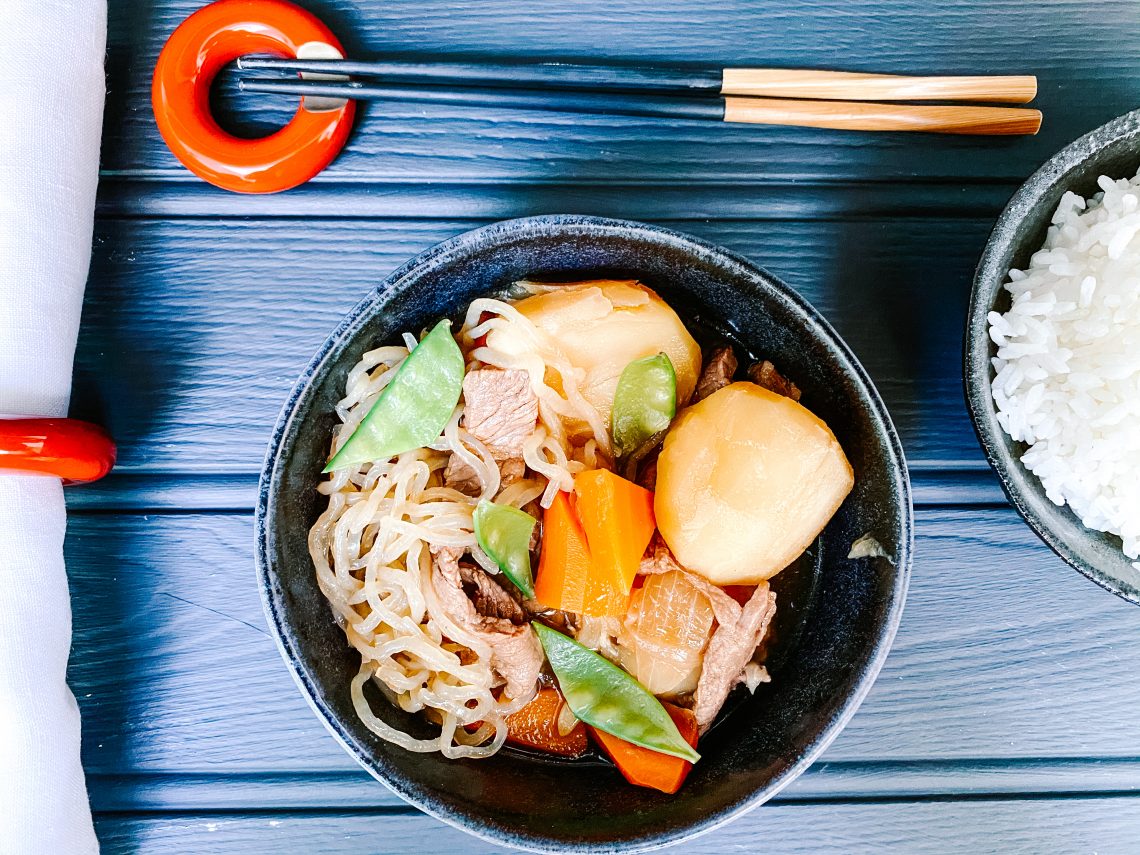
Niku Jaga
Niku Jaga is a warm, comforting Japanese meat stew made from potatoes, sliced beef, (although pork is often used in Eastern Japan) shirataki noodles, carrots, onion and a delectable sweetened stock made from dashi, soy sauce, cooking sake and mirin.
It claims to be Japan’s most commonly made comfort food; it is made in most homes and served in most izakayas. Izakaya are Japanese bars which serve food. The food is mostly ordered throughout the evening and shared, rather like tapas. The setting is informal and you sit either at small tables or at the bar where you can sometimes watch the food being prepared. They are intrinsically friendly and sociable places where owners pride themselves on knowing their customers.
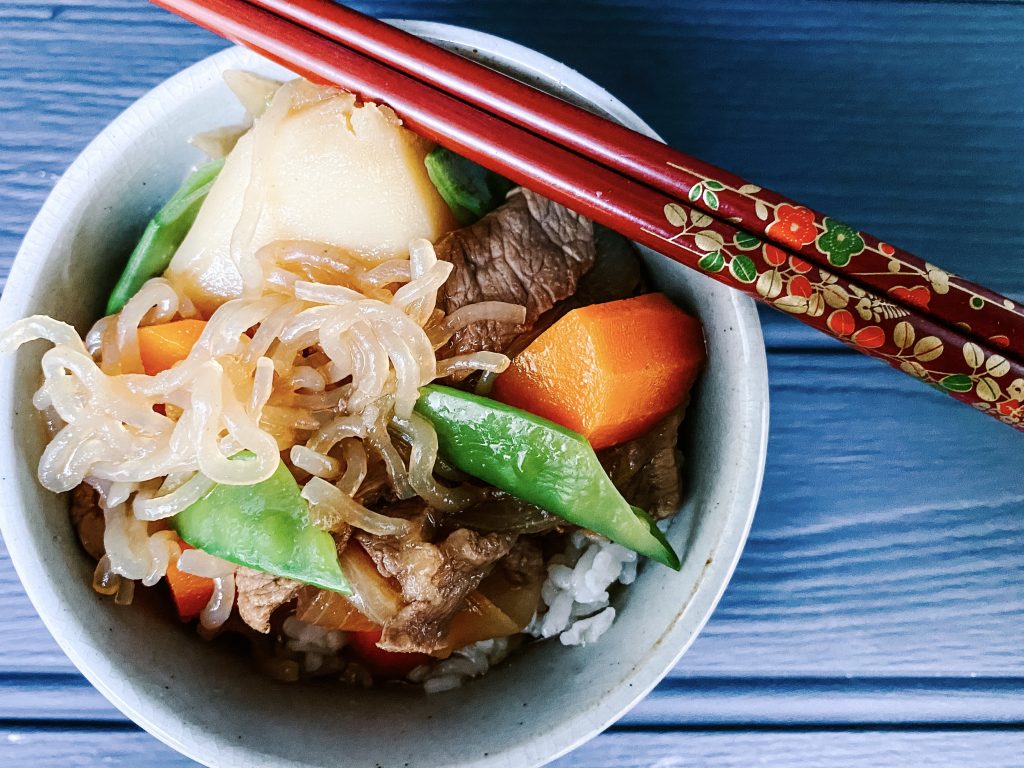
When I moved to Tokyo way back when at the end of the 1980s, I knew no Japanese and had never eaten Japanese food. I used to frequent my local izakaya and this is where I first ate Niku Jaga. These days many izakaya have photographs of food on the menu but in those days, it was only the chain restaurants which did that. Ordering was pretty tricky!
I was with friends who ordered Niku Jaga. I loved it and when I asked them what it was called, I thought it sounded like Mick Jagger. Perfect – I could now go to a restaurant and order food. Mick Jagger onegaishimasu (please) and, hey presto, I’d have a steaming hot bowl of this delicious and comforting stew. It was a seminal moment on my Japanese food and language journey! I thought this was a pretty unique story but when researching the history of this fabulous dish, it appears it is not as unique as I thought, and others have survived before and after me by asking to eat Mick!
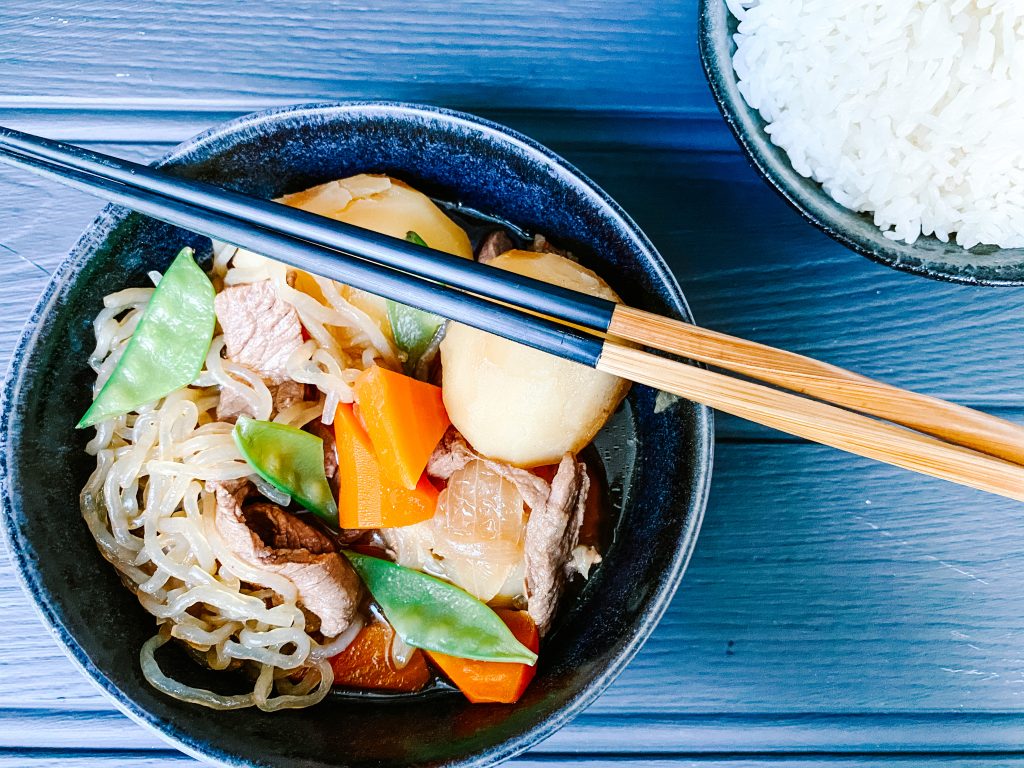
Niku Jaga translates literally as meat potato. Potato makes up the bulk of the ingredients with meat, mainly being added for flavour. Although the seasoning in the stock and the shirataki noodles are intrinsically Japanese, this dish is popular with westerners because it feels familiar and is, in fact, a marriage of eastern and western cuisines.
During the build-up to the Anglo-Japanese Alliance in 1902, British and Japanese troops trained together and participated in joint naval exercises. Japan was looking to culturally assimilate some traditions from Britain to support the alliance plus the British soldiers were struggling with the simpler and lighter Japanese foods which would have tasted very alien to them. Admiral Togo, Admiral of the Japanese Fleet and arguably one of Japan’s most revered naval heroes, asked the Japanese Imperial naval chefs to develop a menu for their British guests. Niku Jaga is a Japanese interpretation of a British stew.
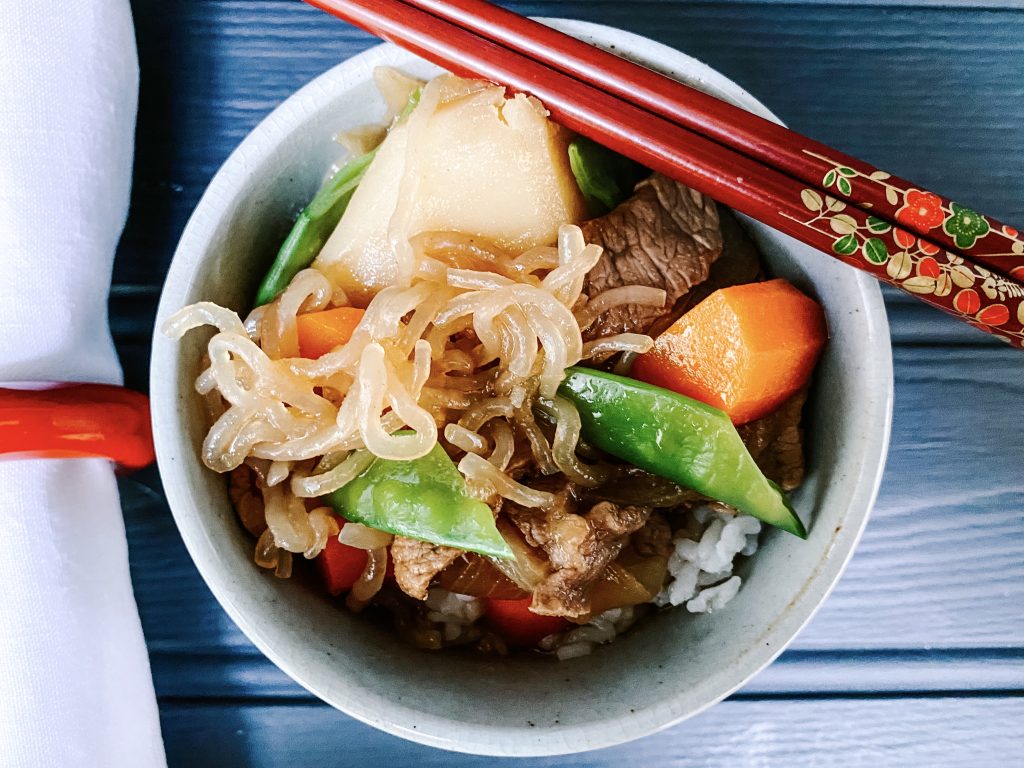
Quick and easy to make, Niku Jaga doesn’t need to be cooked for as long as British stews because it uses beef which is thinly sliced. Chuck or rump steak is most commonly used. It basically needs to be cooked for as long as the vegetables take to cook and then allowed to steep in the stock for a short time to allow the flavours to develop and be absorbed.
Most of the ingredients you need for this dish are available in large supermarkets these days. Certainly everything, apart from the dashi stock, can be bought from Ocado. Dashi stock can be bought on-line from Amazon and the Japan Centre is also an excellent source of Japanese ingredients.
This recipe is very, very slightly adapted from Just One Cookbook. Nami is a Japanese home cooked based in San Francisco and her blog/website is an amazing resource covering all aspects of Japanese cooking as well as travel and culture.
How to make Niku Jaga
Collect all your ingredients together:
For the stew:
- large onions
- carrots
- medium potatoes
- thinly sliced beef – chuck or rump
- shirataki noodles
- snow peas/mange tout for decoration,
- vegetable oil
For the stock and seasoning:
- dashi stock
- mirin
- soy sauce
- cooking sake
- sugar
This stew is quick and easy to prepare and is ready in less than an hour.
Mix together the seasoning:
First, make the seasoning. Simply add the soy sauce, cooking sake and mirin to the sugar and stir to mix. The sugar will dissolve as you prepare the rest of the stew.
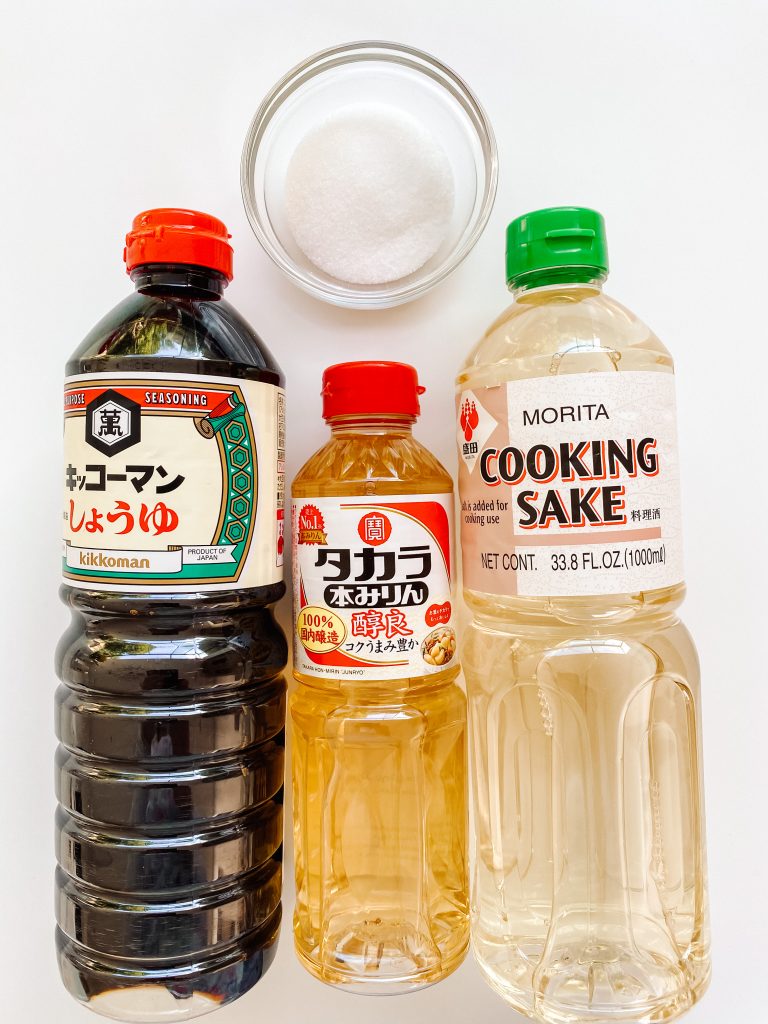
Seasoning ingredients 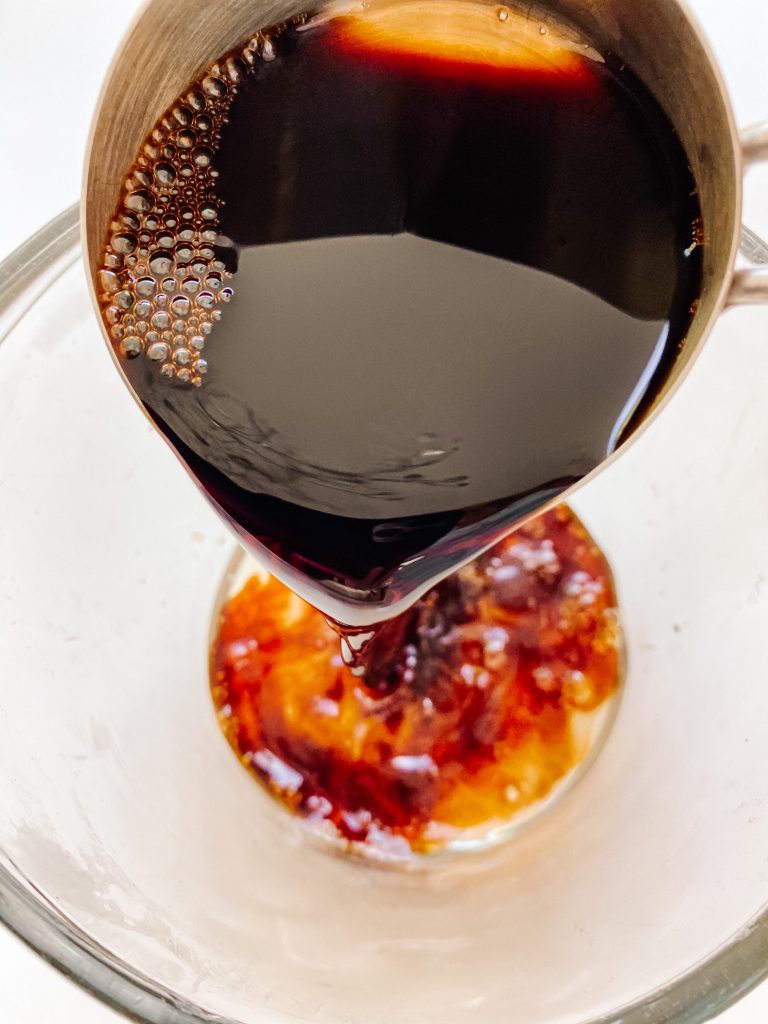
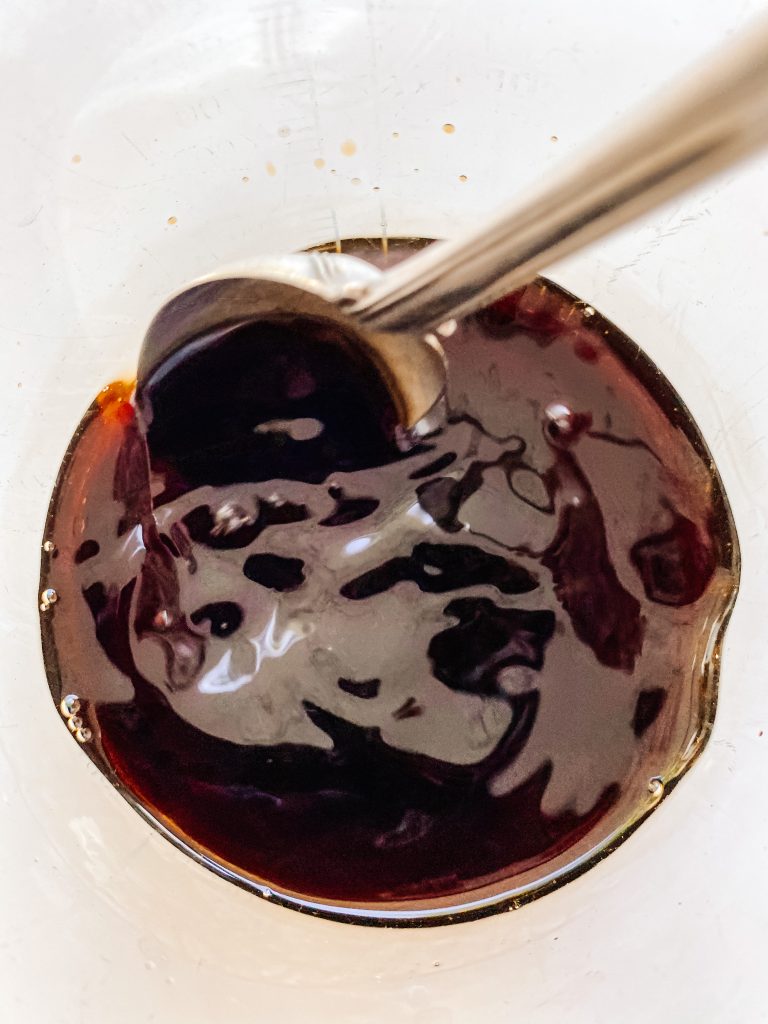
Mix the dashi stock:
Next, mix together the dashi stock. I use instant dashi stock powder. Stir the powder into the water and stir well to mix. I use two pouches per 1 litre of water.
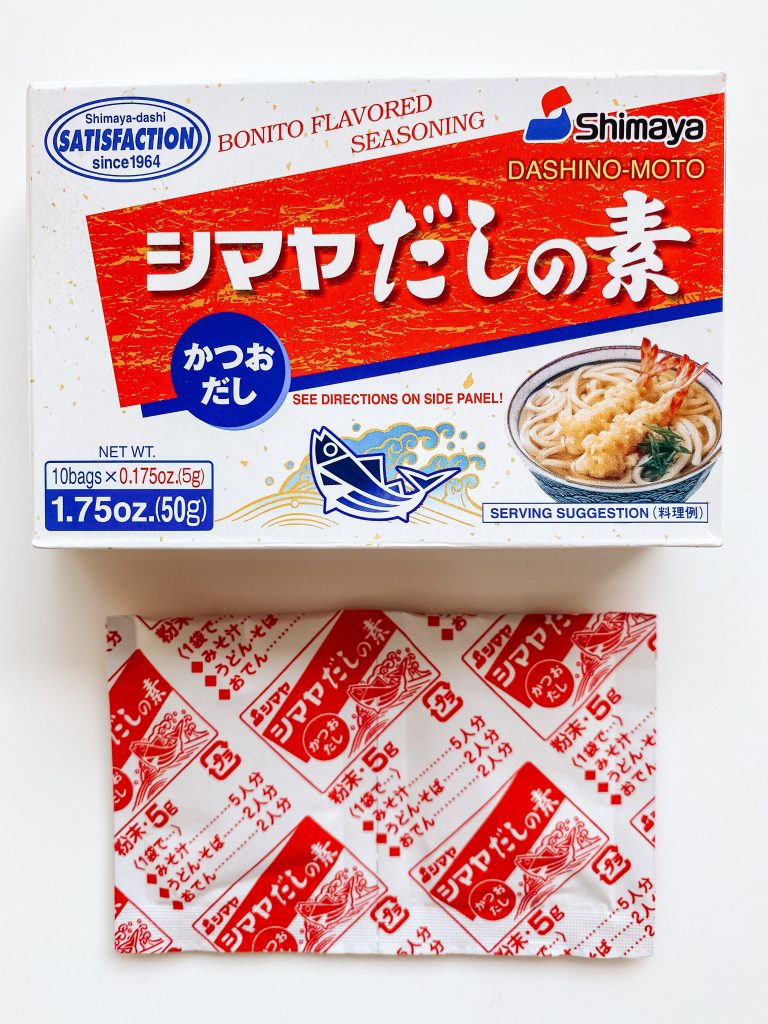
Dashi stock powder 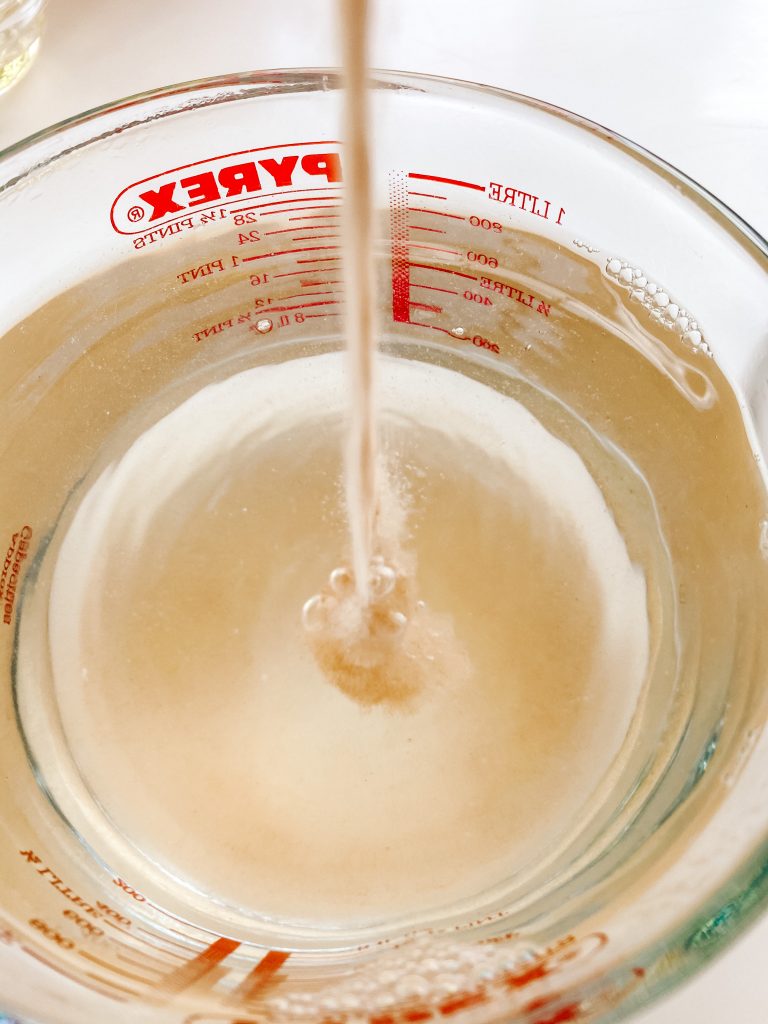
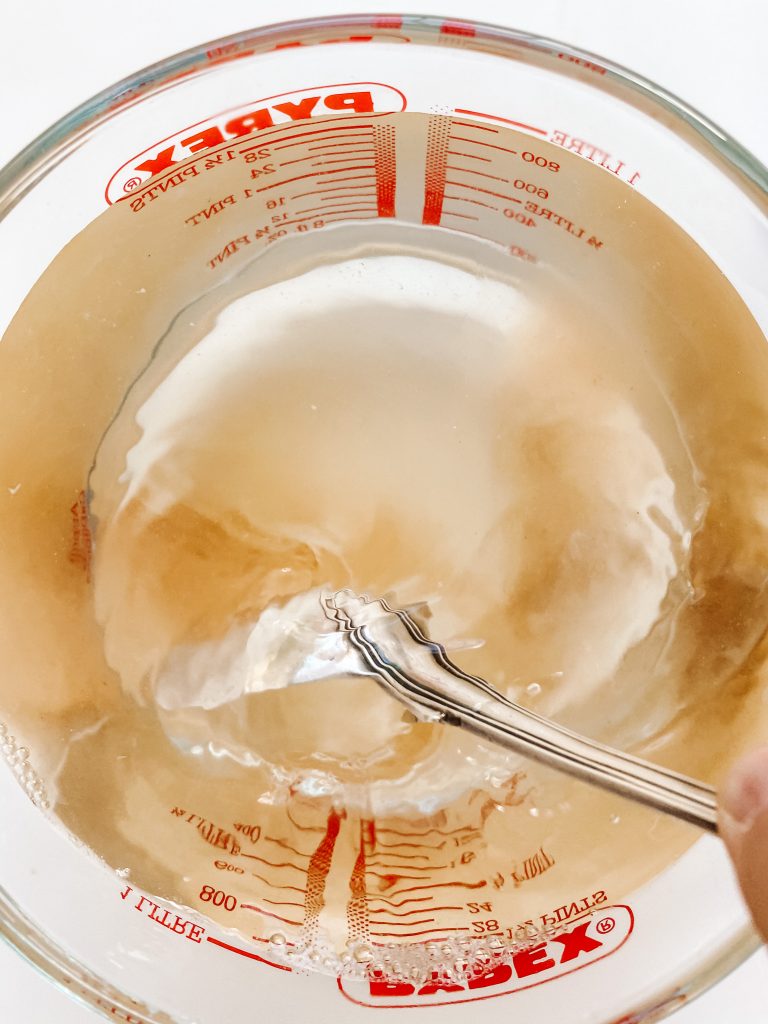
Prepare all the ingredients:
- Peel the potatoes.
- Cut into quarters and smooth the edges of the potatoes. If the pieces have sharp edges then they are likely to break into pieces during the cooking process from bumping into each other. This Japanese cutting technique is called mentori. Soak the potatoes in water to remove starch.
- Peel and cut each onion in half and each half into 6 wedges.
- Peel and cut the carrot in half lengthwise and chop into rolling wedges.
- Cook snow peas/green beans in boiling water for 10 seconds and take them out.
- Drain and rinse the shirataki noodles.
- Add the shirataki noodles to the boiling water and cook for 1 minute. Drain well.
- Cut the noodles in half.
- Thinly slice the beef – top tip: it is much easier to slice beef thinly if you put it in the freezer for half an hour before you slice it.
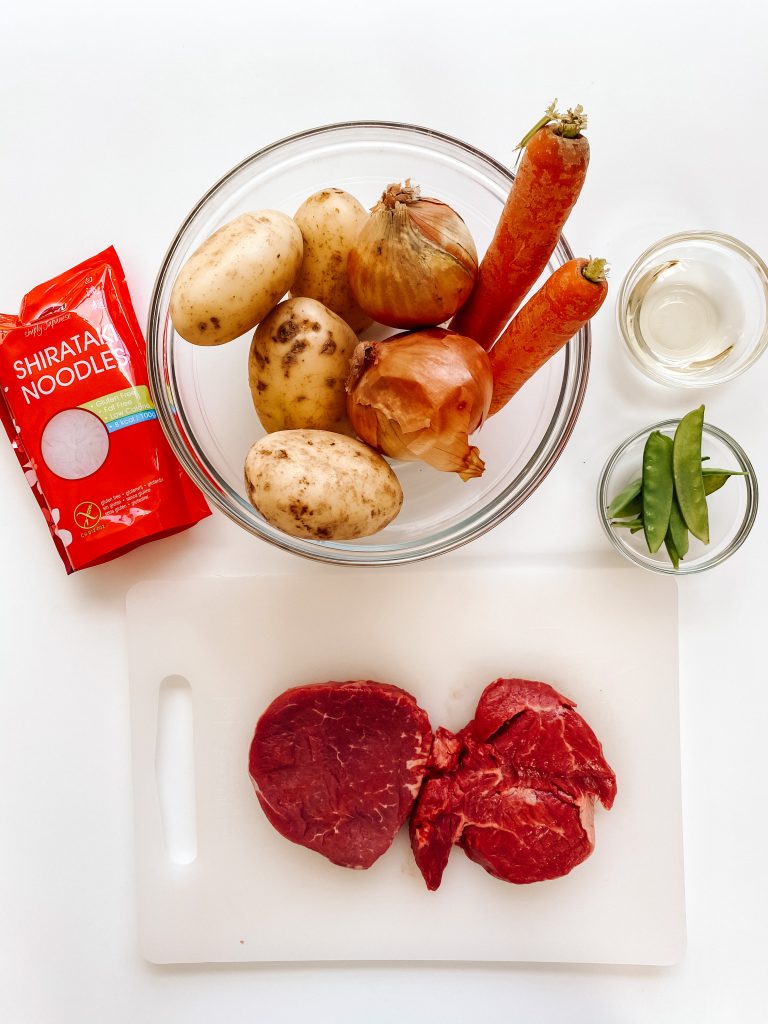
Stew ingredients 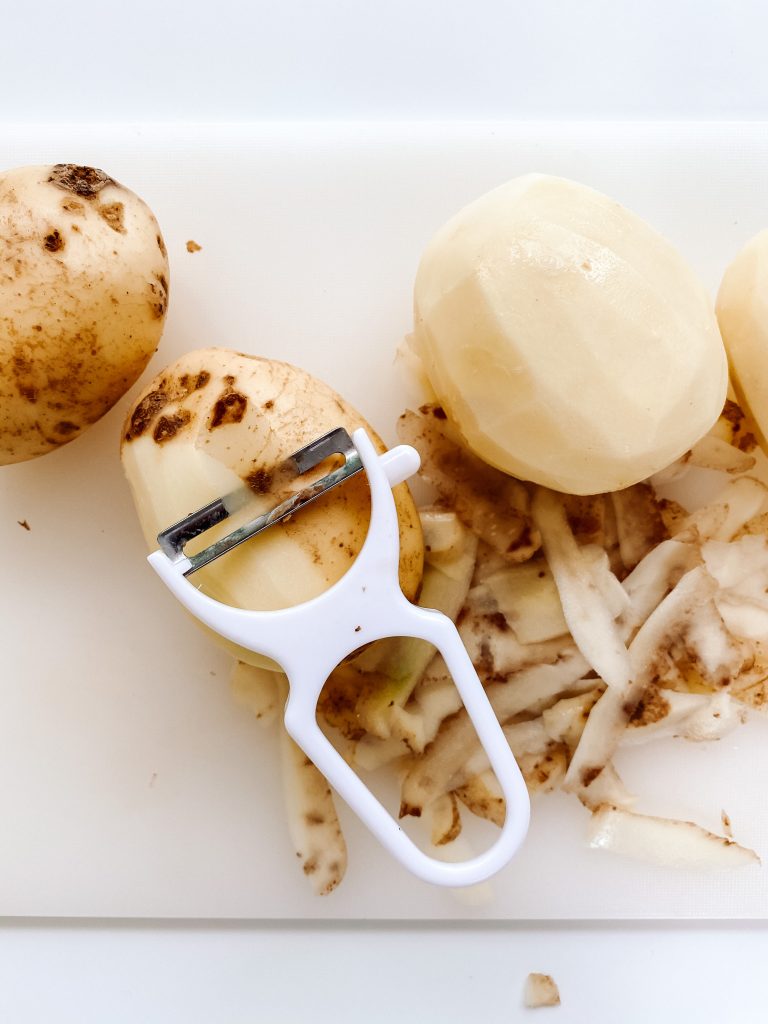
1 Peel the potatoes 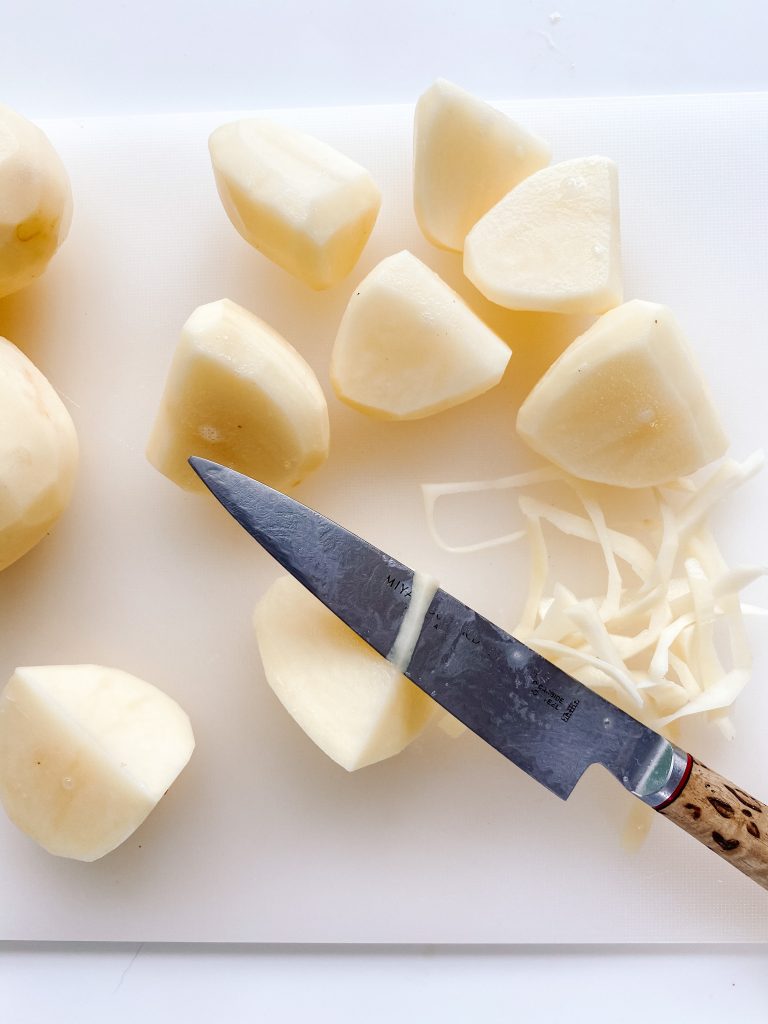
2 Quarter the potatoes and smooth the edges. 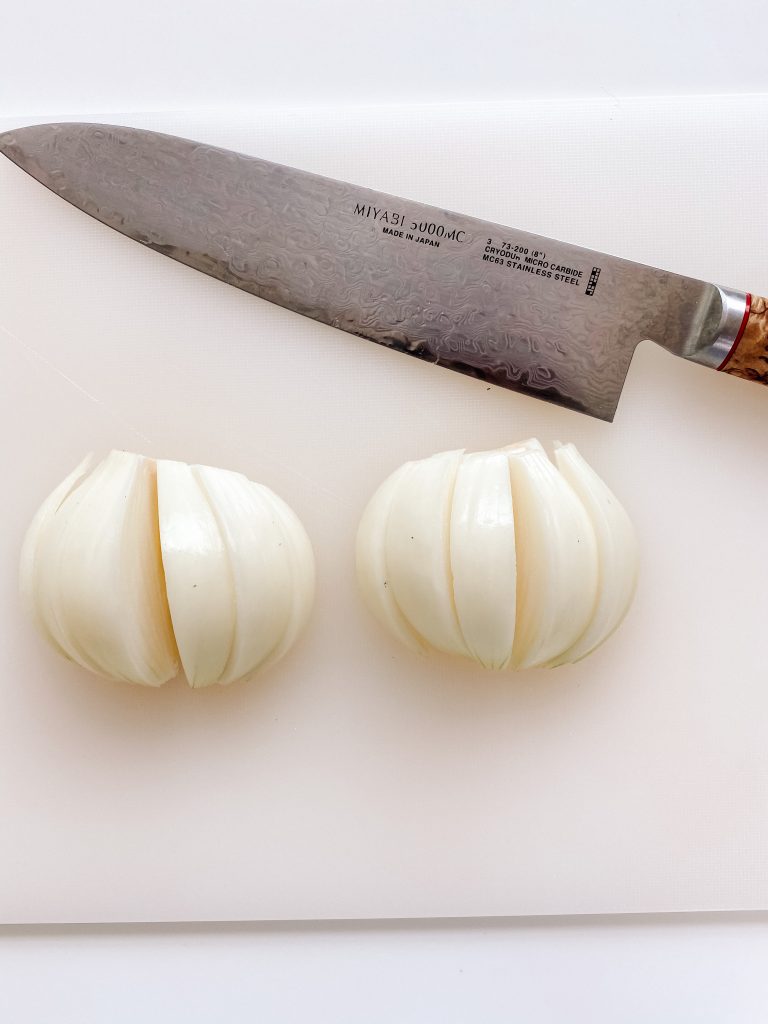
3 Cut each onion into 12 pieces 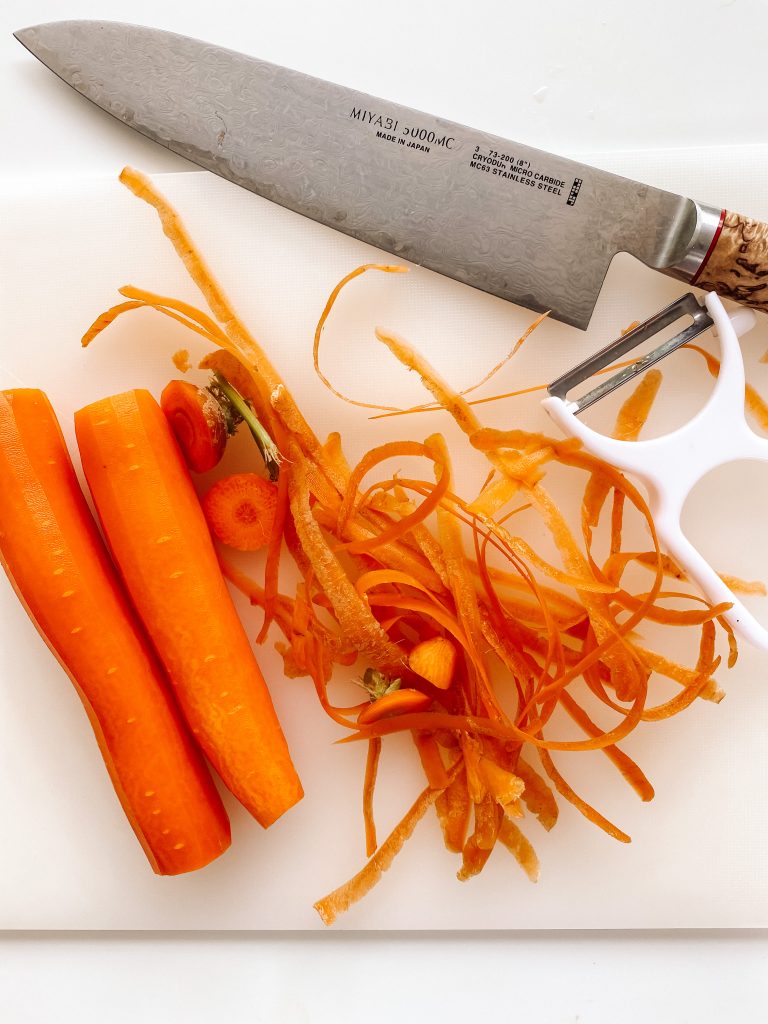
4 Peel the carrots…. 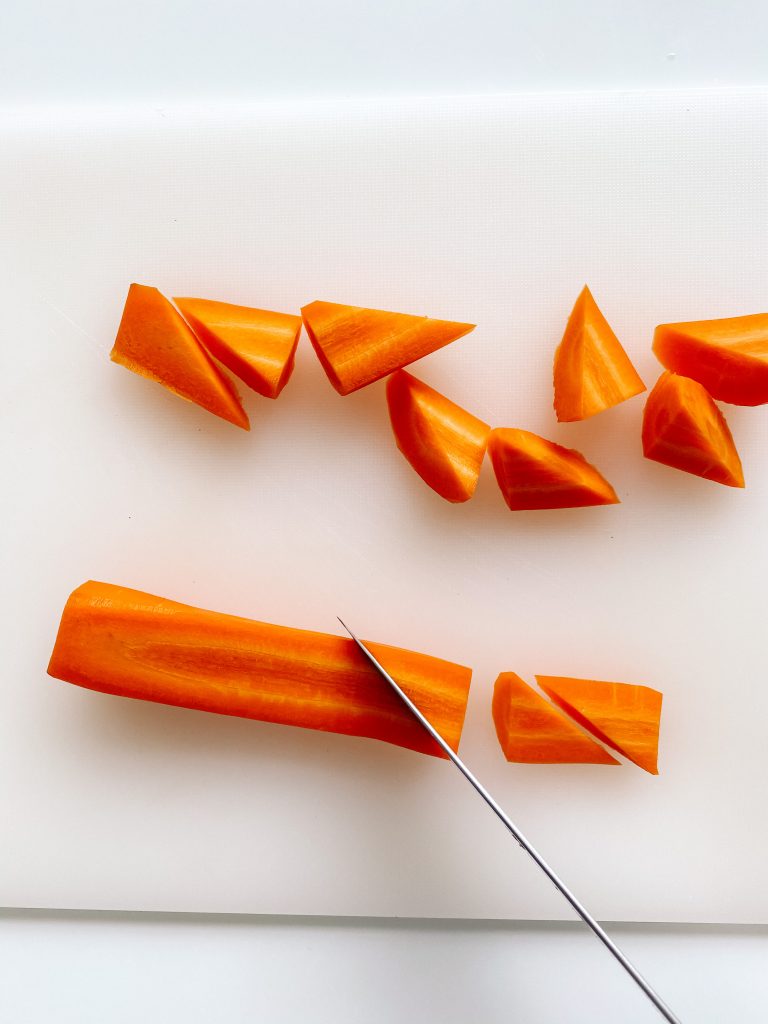
…. Cut the carrot lengthwise and cut into rolling wedges 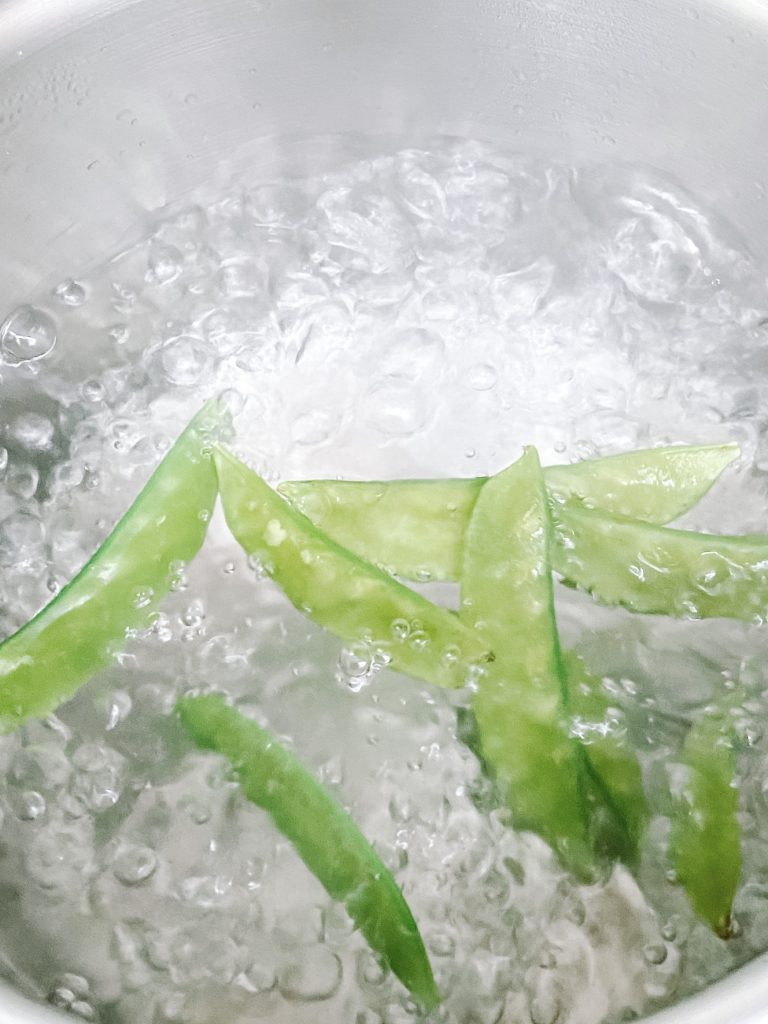
5 Cook the mange tout for 15 seconds 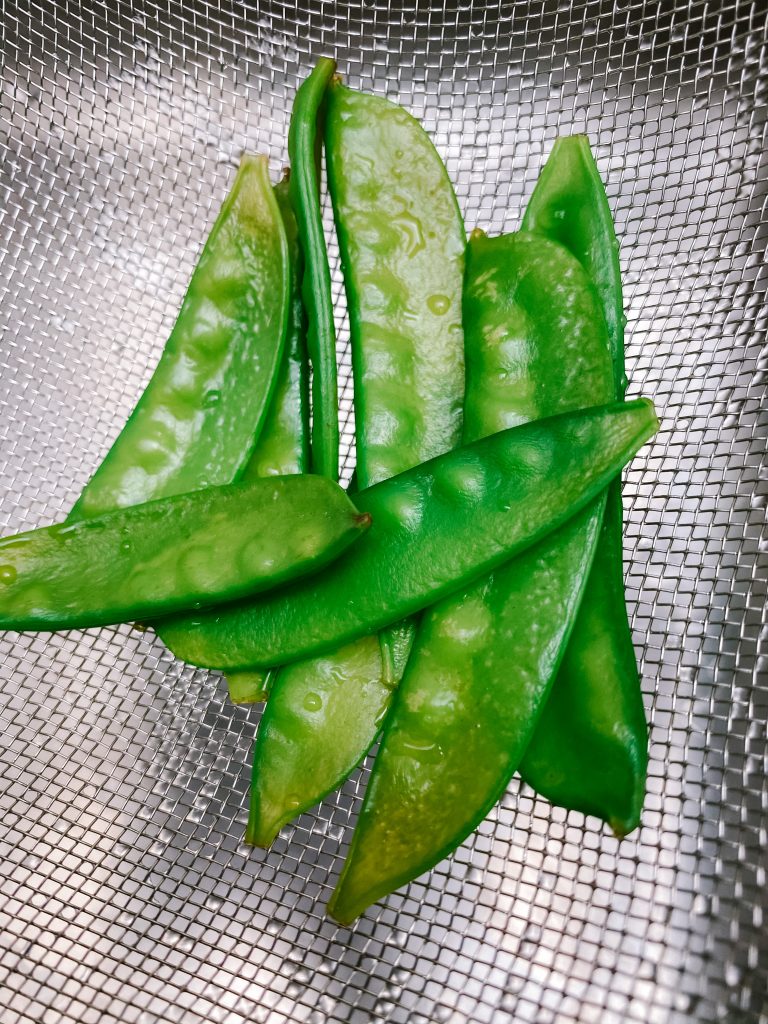
….5 Drain immediately 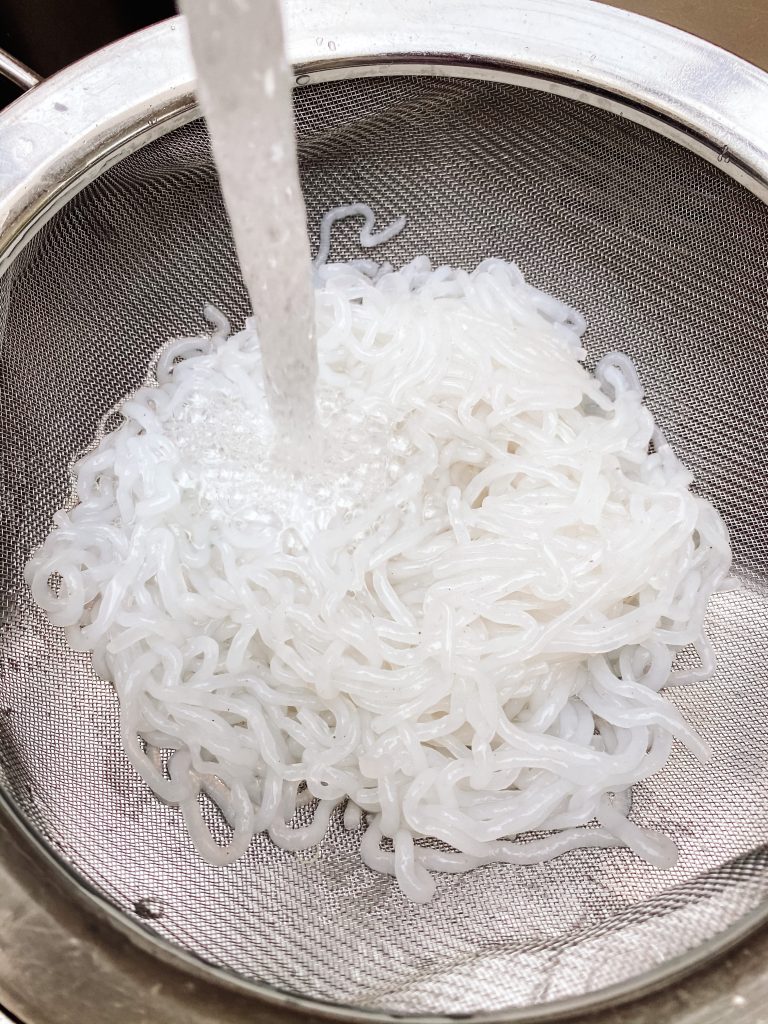
6 Rinse the shirataki noodles…. 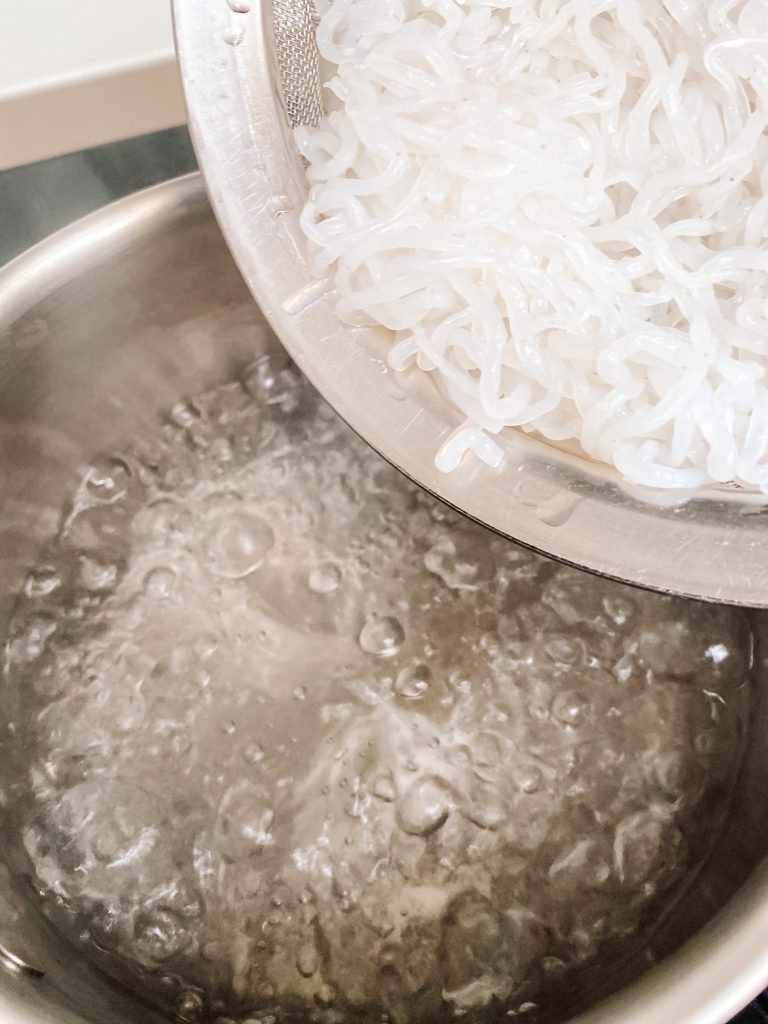
7. Cook in boiling water for 1 minute and drain well 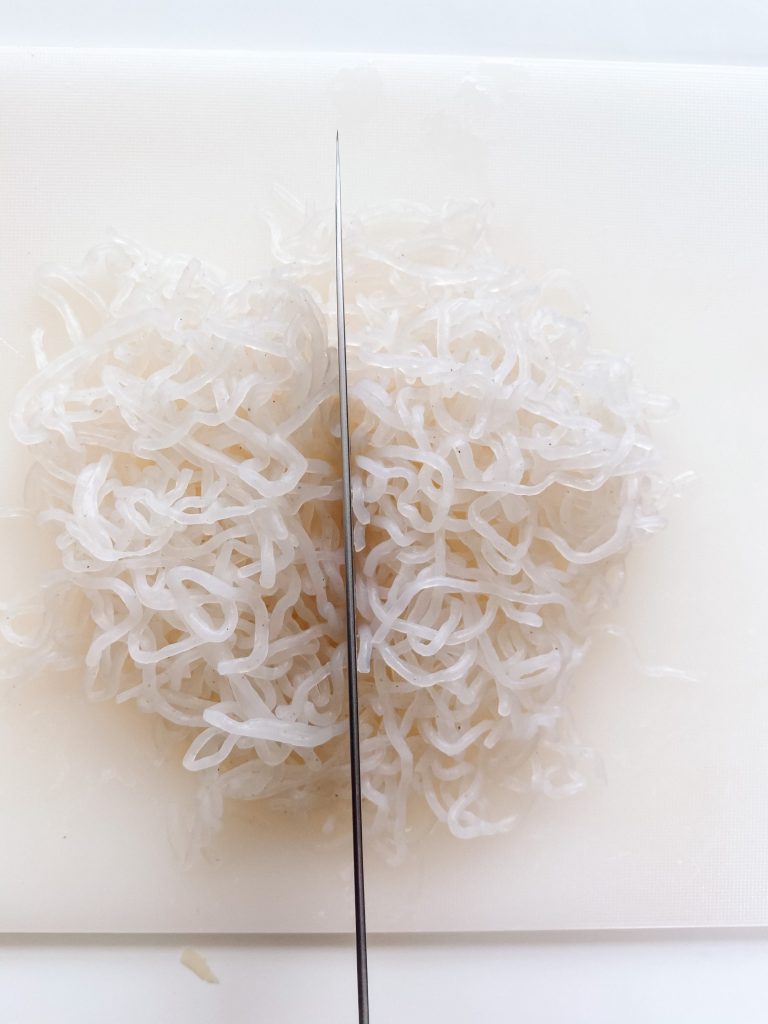
8 Cut in half 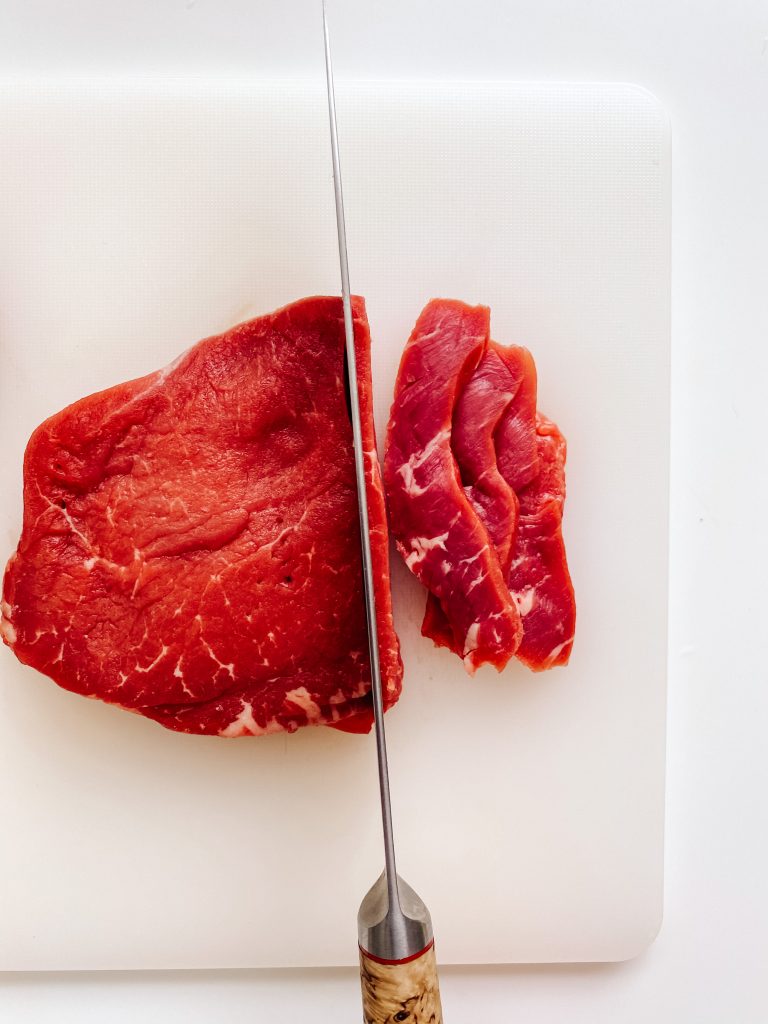
9 Thinly slice the beef
Cook the Niku Jaga:
- Using a large pot, heat the oil on medium
- Sauté the onion for 5 minutes until lightly caramelised.
- Add the beef.
- Cook until no longer pink.
- Rinse the potatoes
- Add the potatoes, carrots, and shirataki noodles – do not mix the ingredients.
- Add seasonings
- And the dashi stock. Bring gently to the boil.
- Simmering gently, skim the scum from the surface and discard.
- Meanwhile using the lid of your pot as a size guide, make an ‘otoshibuta’ (drop lid) out of aluminium foil. This helps the heat to distribute evenly. It helps prevent the food from moving and ensures the different ingredients stay submerged in the stock. It also reduces the chance of large bubbles forming which can put stress on the food. As such, it will help to ensure that fragile ingredients, in this case the potatoes, keep their shape.
- When the stock is as clear as you can make it, make sure as many ingredients as possible are submerged.
- Cover with the ‘otoshibuta’ and a lid
- Cook for 15-20 minutes or until all the vegetables are cooked through. Turn off the heat and let it stand for 30 minutes before serving so the ingredients can further absorb the flavours. I cook mine for 20 minutes because we like the potatoes very soft – cooking for 15 minutes is perhaps slightly more traditional. However cooking time will also depend on the size and type of your potatoes.
- When you heat it up again prior to serving, pour the soup on top of the ingredients with a spoon a couple of times. When it’s almost ready, toss in the snow peas to warm them up. Make sure all the ingredients are piping hot before you serve.
- I like to serve my Niku Jaga either on or with rice on the side to absorb all the delicious stock. Although my photographs show chopsticks, I also use a spoon to catch all the wonderful flavours!
NB – I confess I don’t always make an ‘otoshibuta’, but it is the proper way. I do however make sure that the stew is bubbling only very gently and I ensure the ingredients fit snugly in my pot to prevent too much movement. I use a 26inch/66cm cast iron casserole dish.
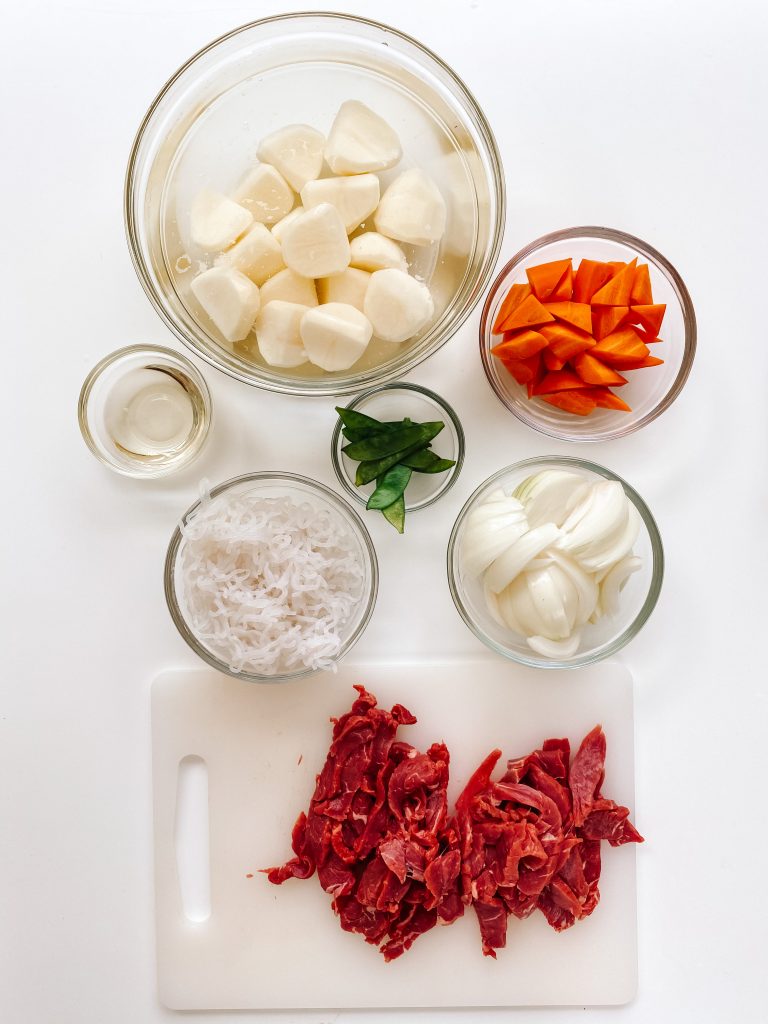
Prepared ingredients 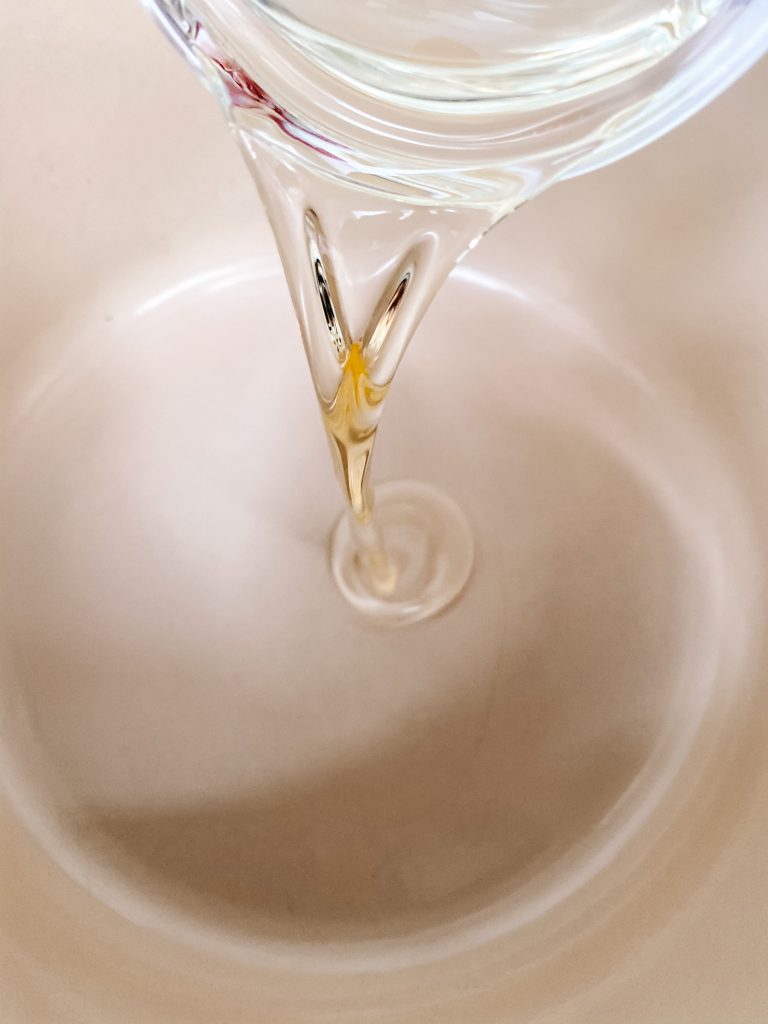
1. Add the oil on medium 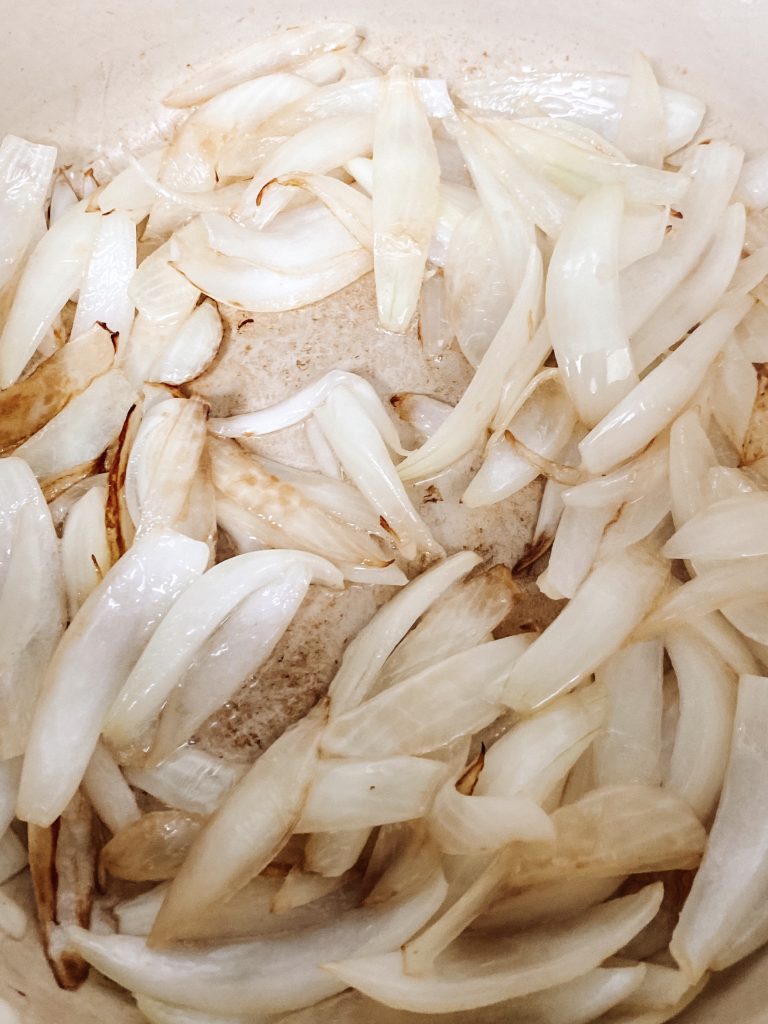
2 Sauté the onion until lightly caramelised. 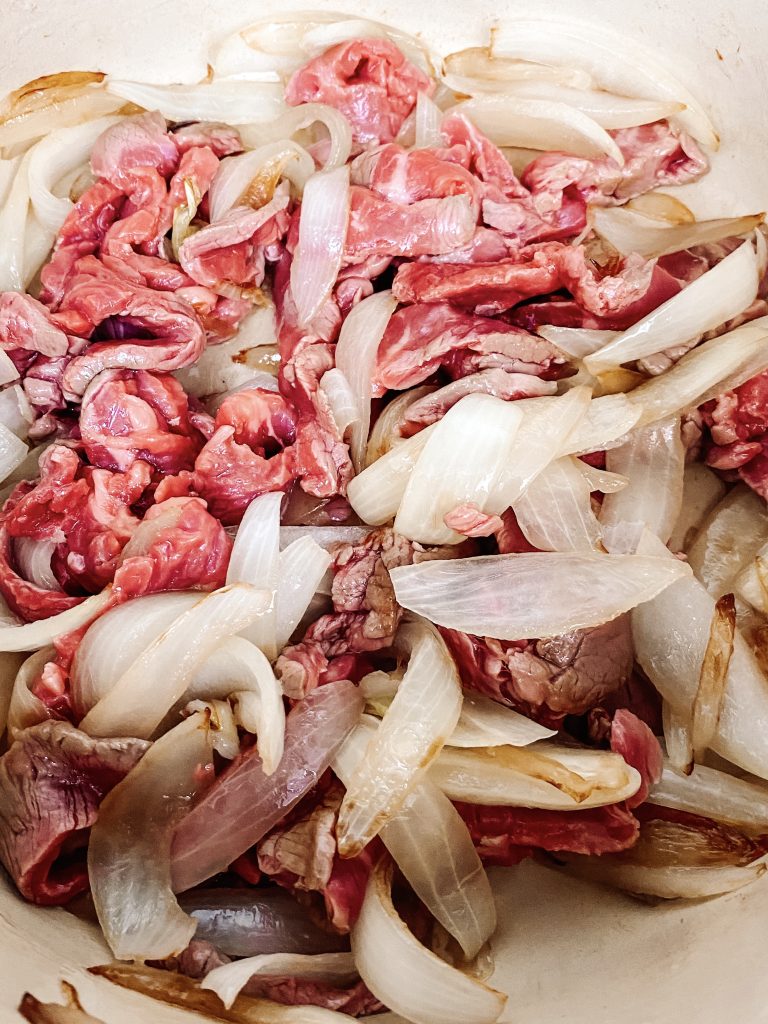
3 Add the beef. 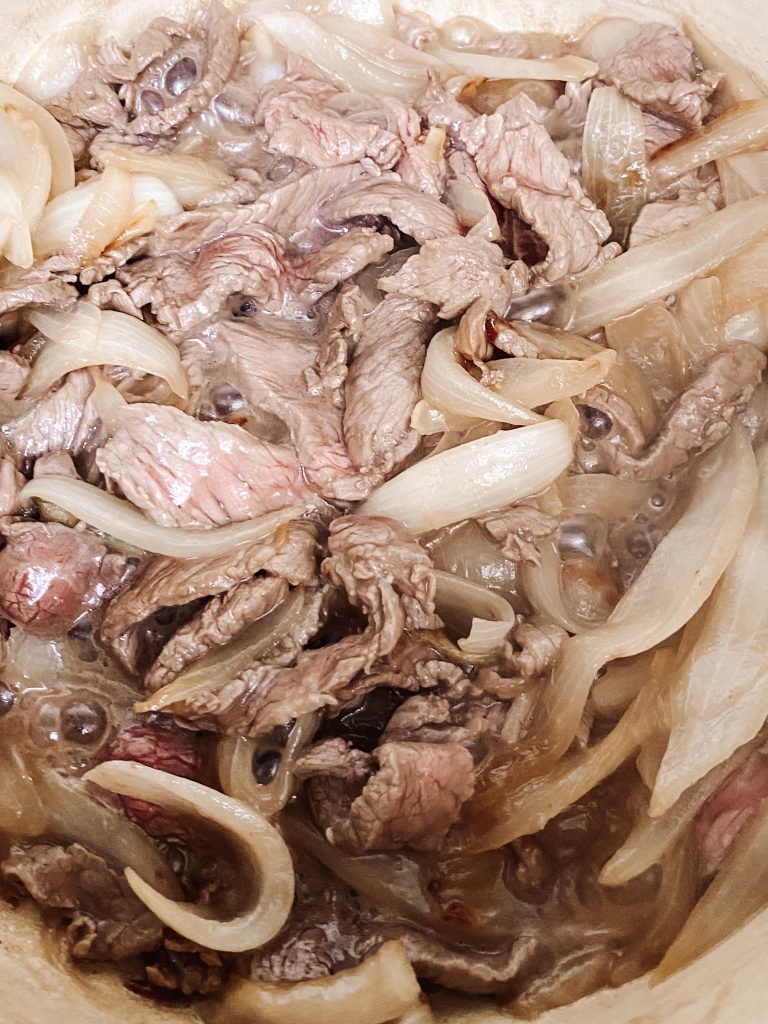
4 Cook until no longer pink. 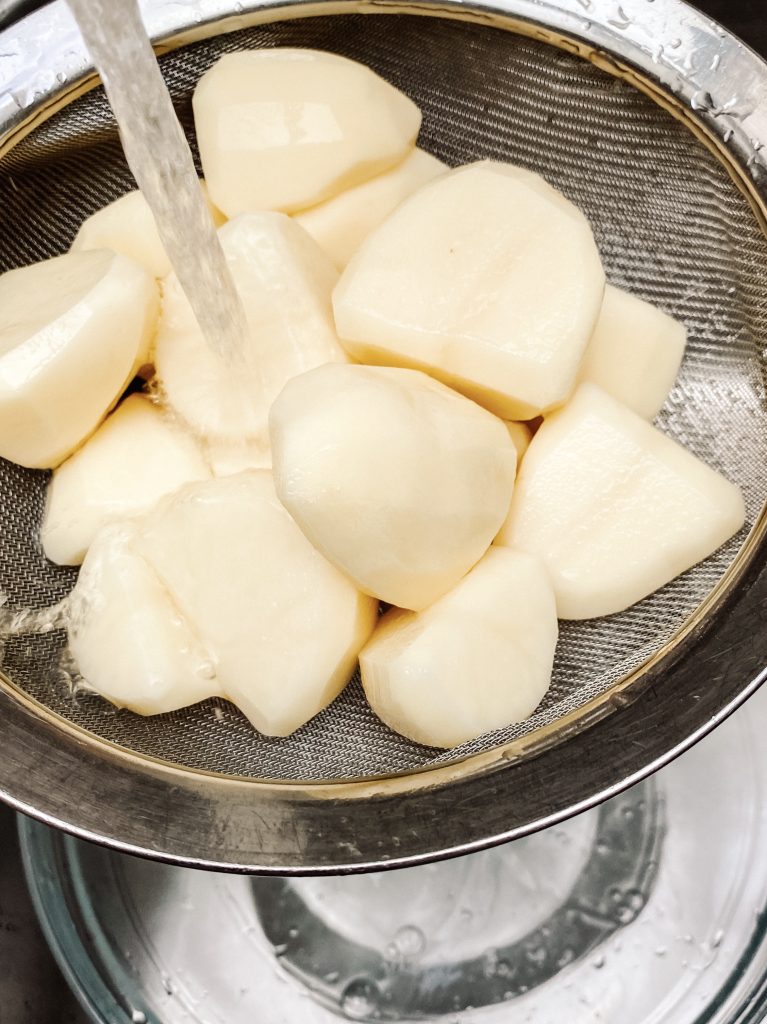
5 Rinse the potatoes 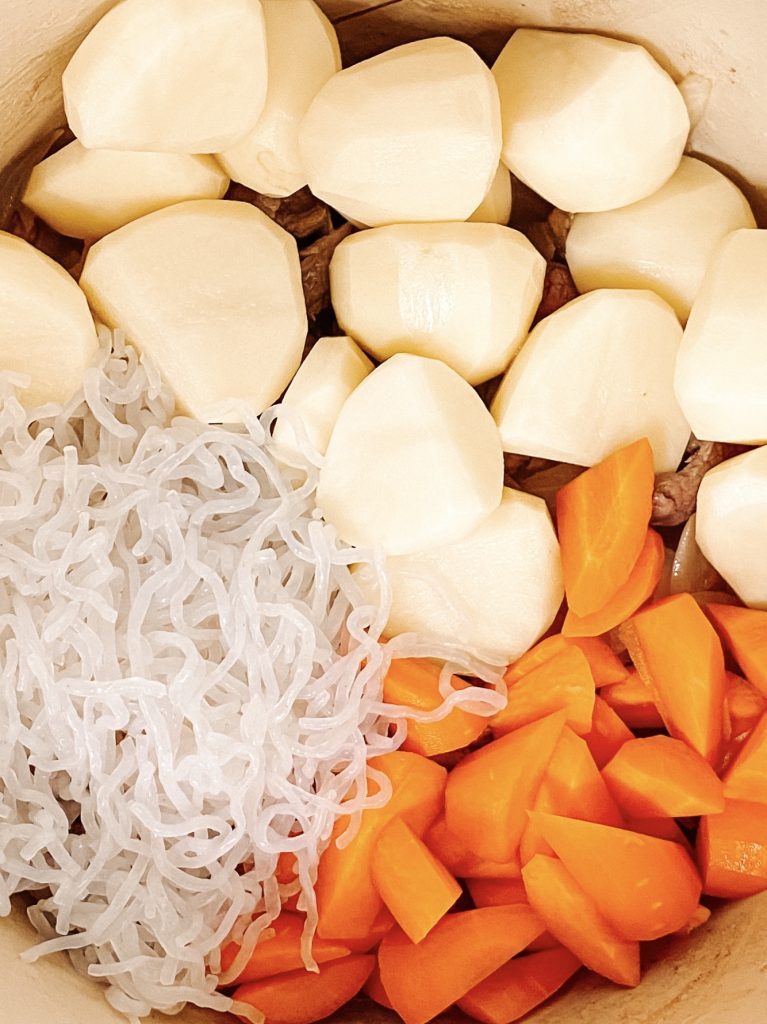
6 Add the potatoes, carrots, and shirataki noodles. 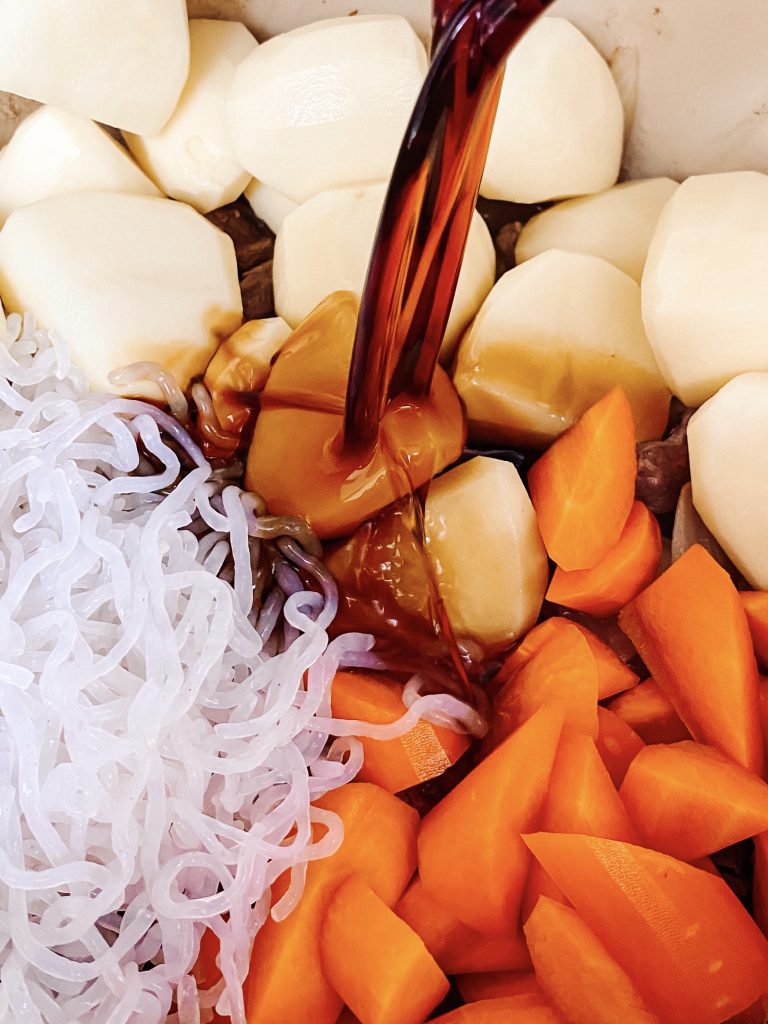
7 Add the seasoning 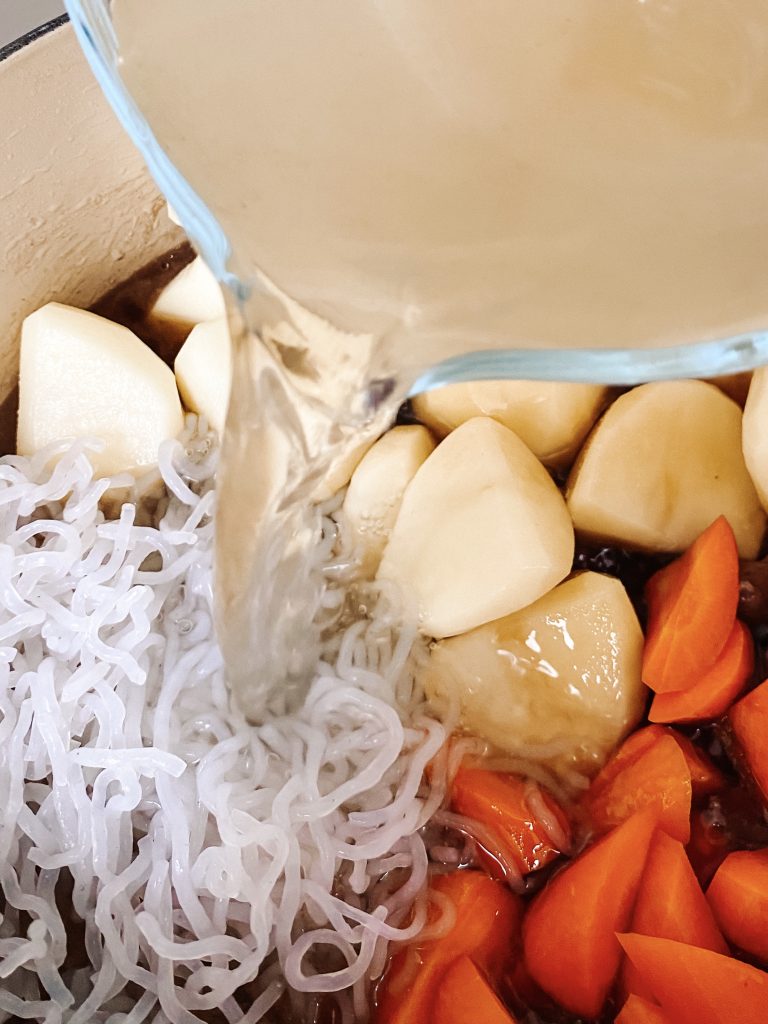
8 Add the dashi stock and… 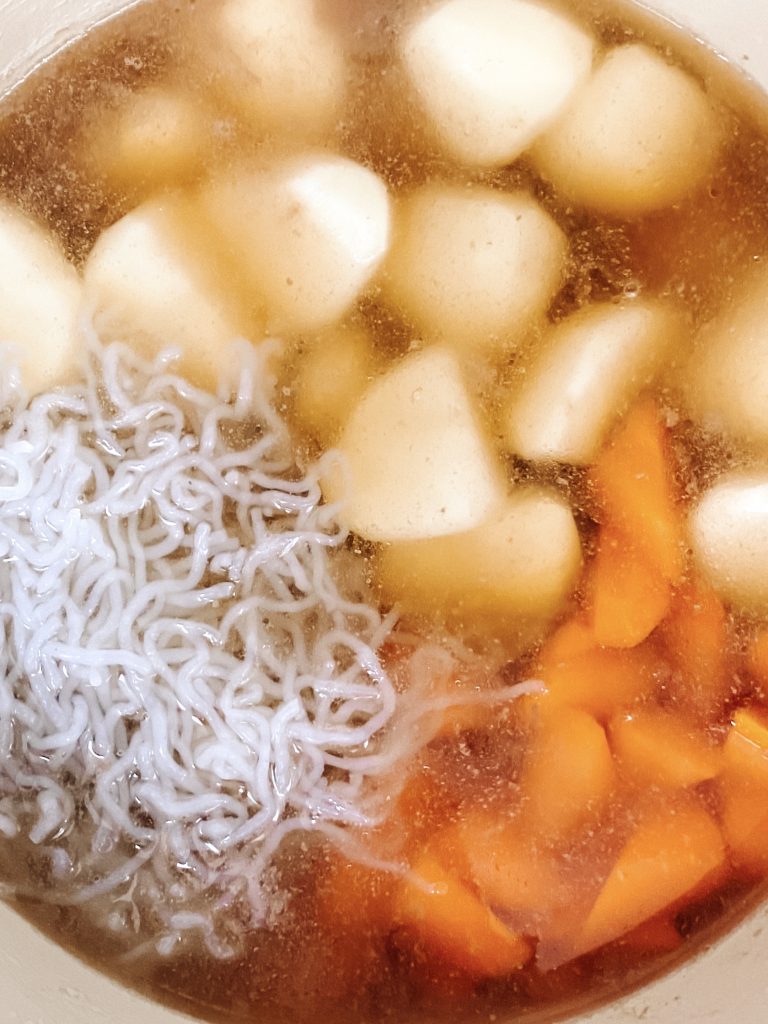
….bring gently to the boil 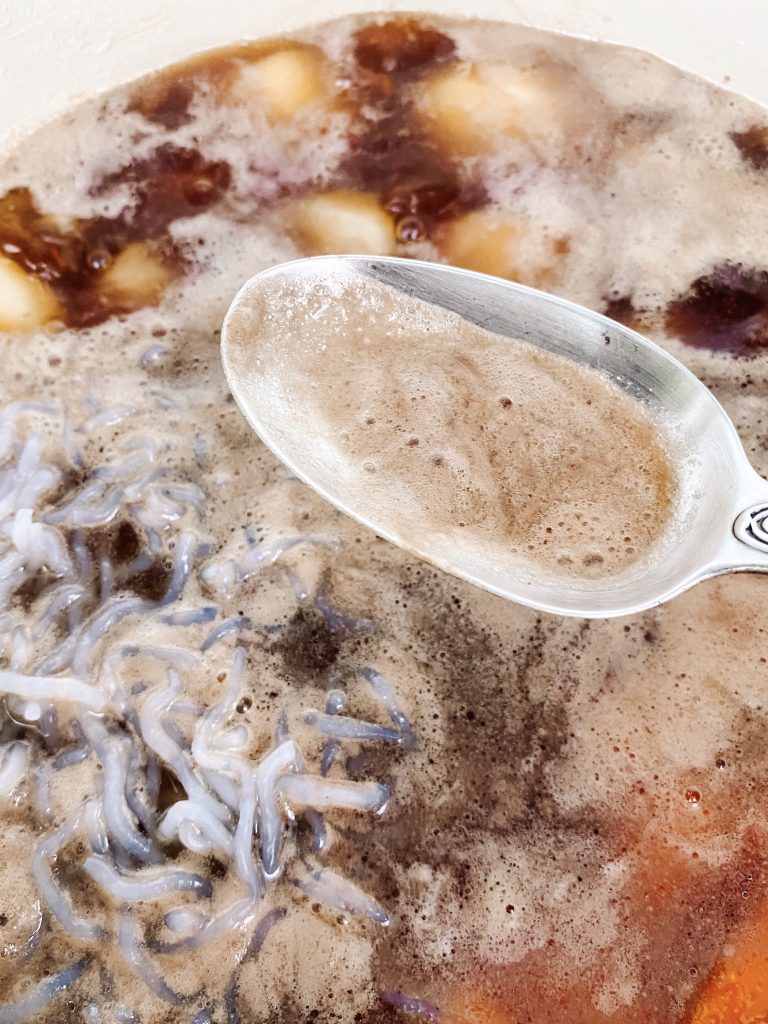
9 Simmering gently, skim off the scum….. 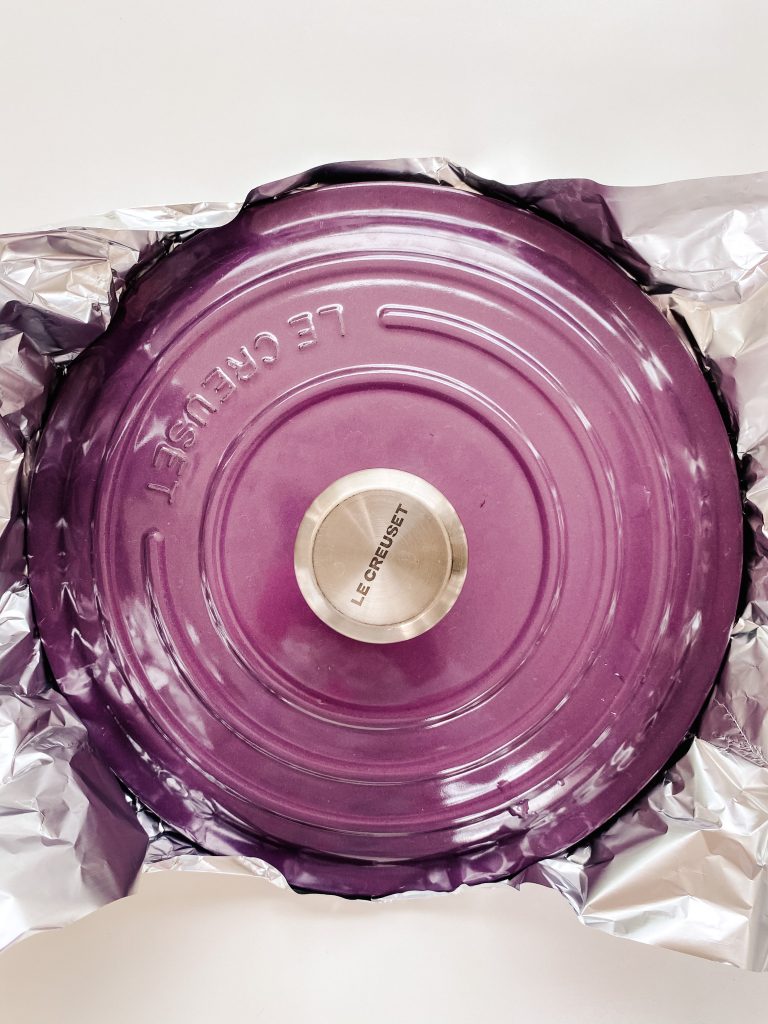
10 Using the lid of your pot as a size guide ….. 
…..make an ‘otoshibuta’ (drop lid) 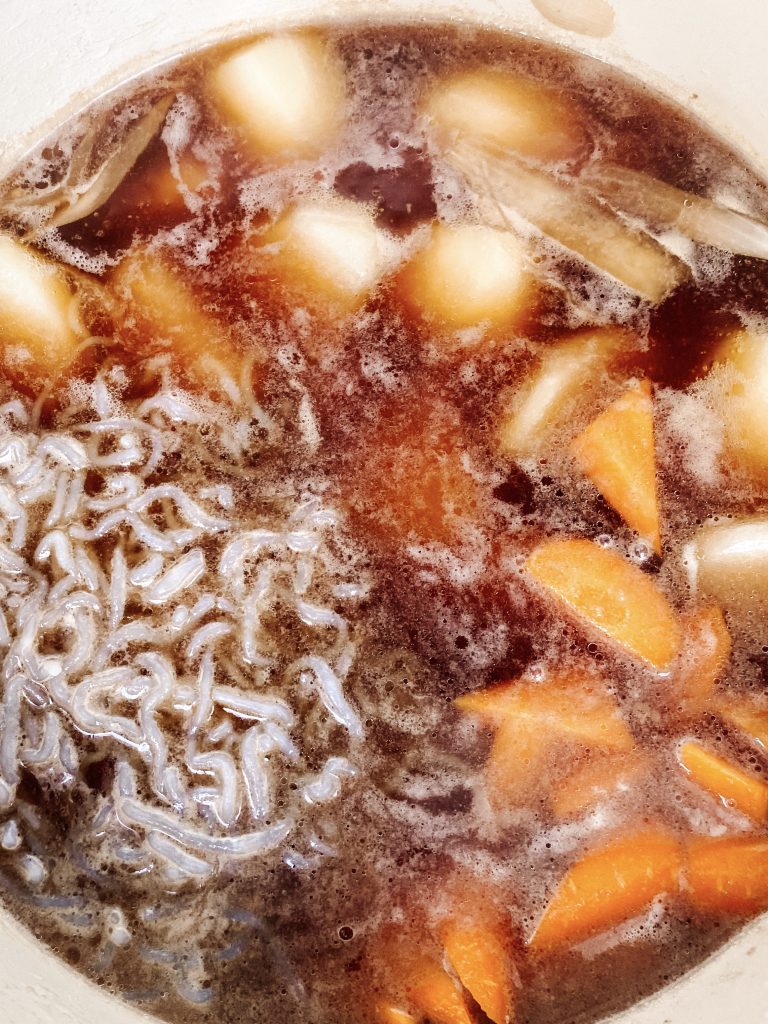
11. When the stock is clear and ingredients submerged 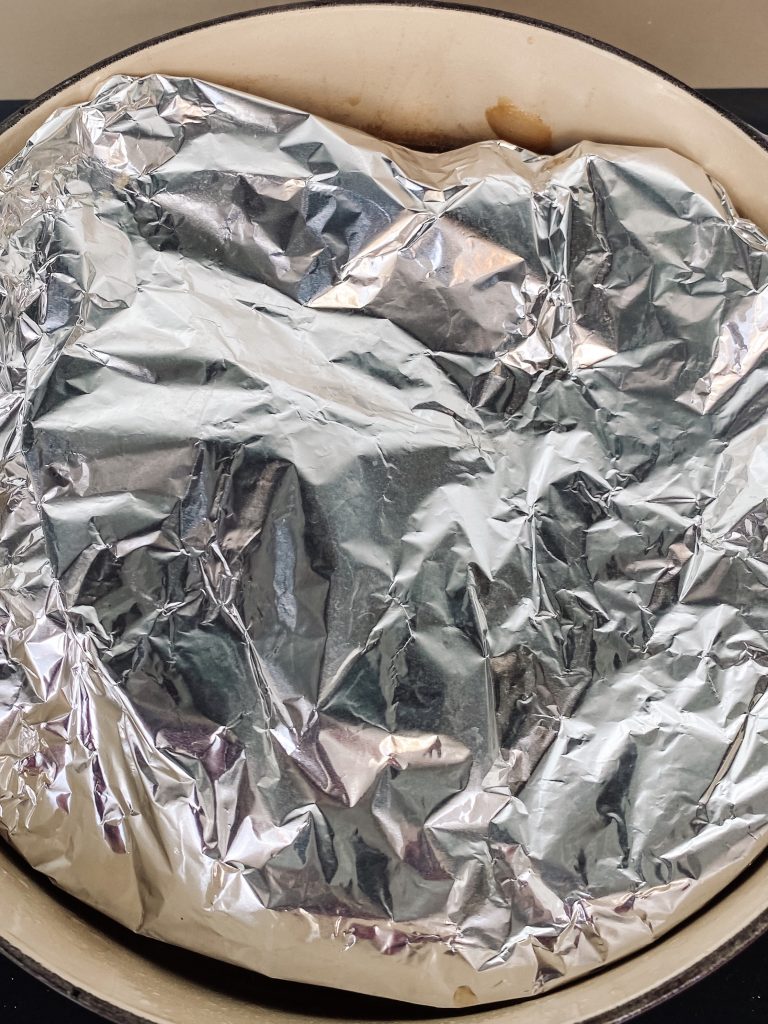
12 Cover with ‘otoshibuta’ 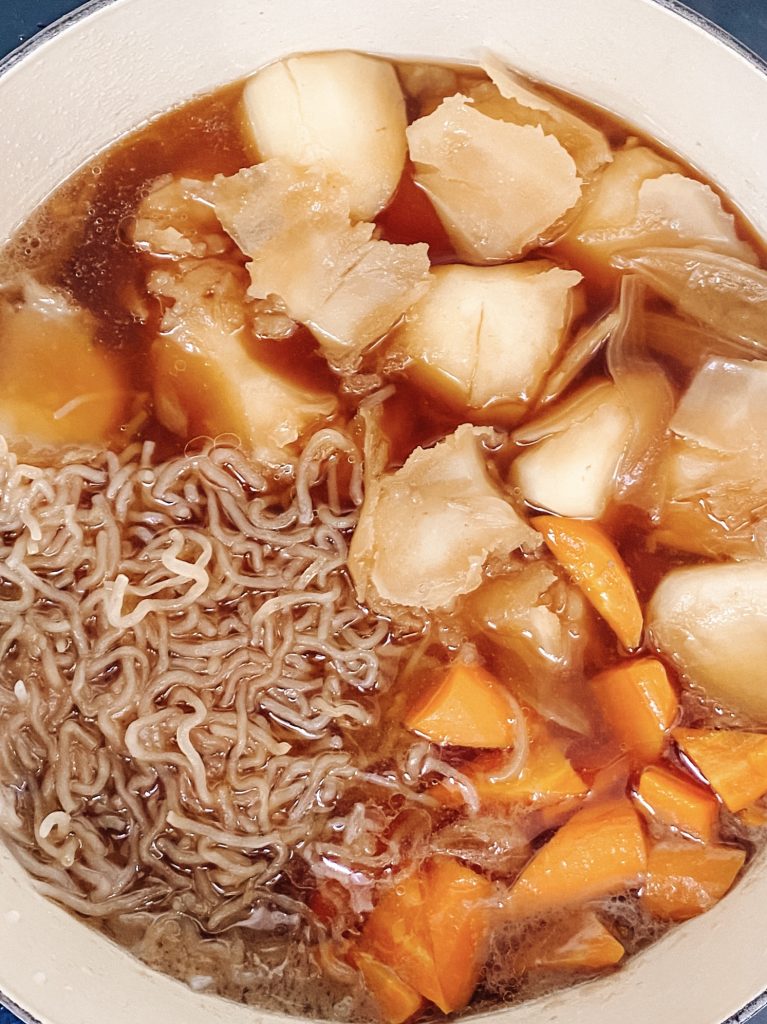
13 Cook for 15-20 minutes or until all the vegetables are cooked through. Turn off the heat and stand for 30 minutes before serving . 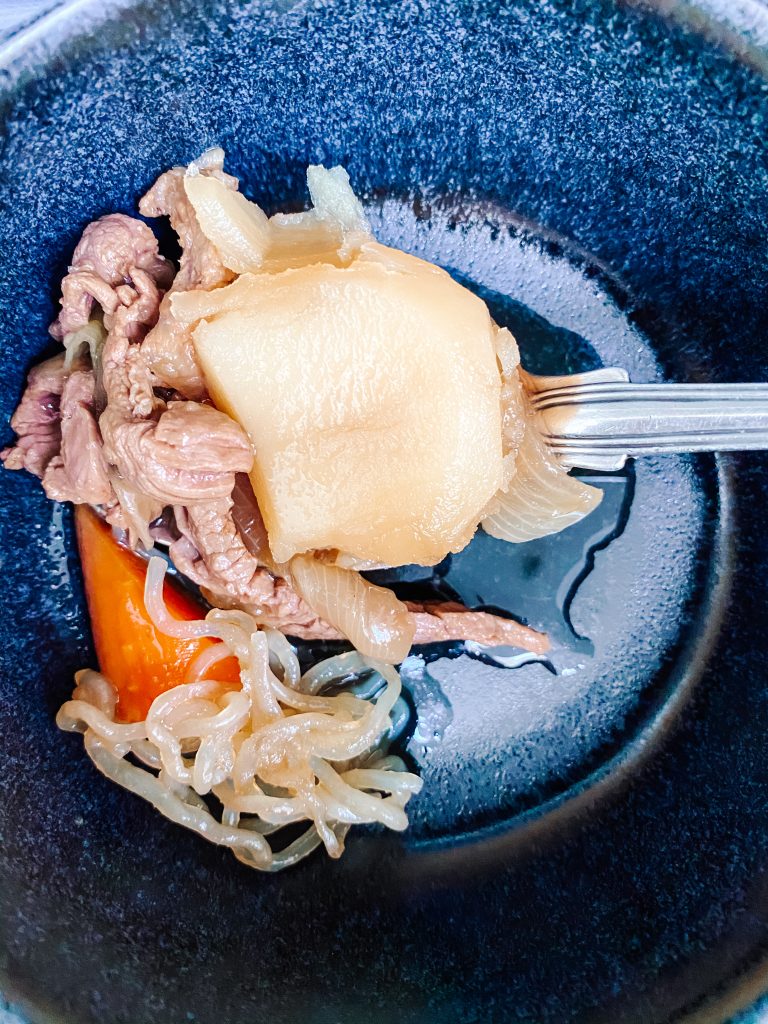
14 Reheat before serving. When it’s almost ready, toss in the snow peas to warm them up.
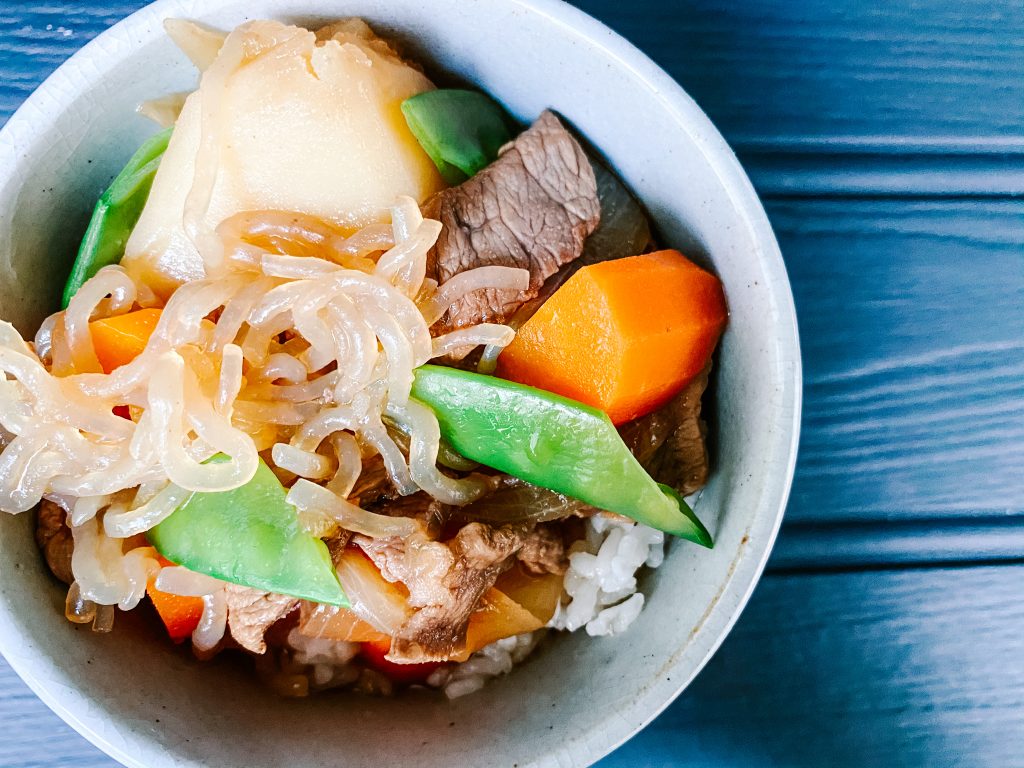
Made this recipe?
If you make this recipe, do please tag me on instagram @daffodilkitchen. You could also leave a comment in the box directly below the recipe.
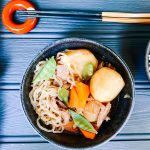
Niku Jaga
Niku Jaga is a warm, comforting Japanese meat stew made from potatoes, sliced beef, (although pork is often used in Eastern Japan) shirataki noodles, carrots, onion and a delectable sweetened stock made from dashi, soy, cooking sake and mirin
Ingredients
For the stock and seasoning:
- ½ cup/120ml soy sauce
- ½ cup/120ml mirin
- ¼ cup/60ml cooking sake
- 2 tablespoons caster or granulated sugar
- 2 pouches of dashi powder
- 1 litre water
For the stew:
- 2 large onions, peeled (roughly 300g in total)
- 2 tablespoons vegetable oil
- 2 medium sized peeled carrots (roughly 150g total peeled weight)
- 4 medium peeled potatoes (roughly 300g total peeled weight)
- 500g beef – chuck or rump
- 200g shirataki noodles
- a few snow peas/mange tout for decoration
Instructions
-
Collect together your equipment (see Recipe Notes below) and ingredients.
-
Beef – Top tip: it is much easier to slice beef thinly if you put it in the freezer for half an hour before you slice it. This is the first thing I do before making a Niku Jaga.
-
Make the seasoning: simply add the soy sauce, cooking sake and mirin to the sugar and stir to mix. The sugar will dissolve as you prepare the rest of the stew.
-
Dashi stock: stir the dashi powder into the water and stir well to mix. I use the two attached pouches per 1 litre of water.
-
Prepare all the stew ingredients:
Potatoes – cut the peeled potatoes into quarters and smooth the edges of the potatoes by trimming the sharp edges. This Japanese cutting technique is called mentori. Soak the potatoes in water to remove starch.
Onions – cut each peeled onion half and then each half into 6 wedges.
Carrots – cut the peeled carrots in half lengthwise and chop into rolling wedges.
Snow peas/green beans – cook in boiling water for 10 seconds and take them out.
Shirataki noodles – drain and rinse the shirataki noodles. Add the shirataki noodles to the boiling water you cooked the snow peas in and cook for 1 minute. Drain well and cut in half.
Beef – thinly slice the beef.
-
Cook the Niku Jaga:
Using a large pot, heat the oil on medium and sauté the onion for 5 minutes until lightly caramelised.
-
Add the beef and cook until no longer pink; just a couple of minutes.
-
Rinse the potatoes and add to the onions and beef along with the carrots and shirataki noodles – do not mix the ingredients
-
Pour in the seasonings and the dashi stock. Bring gently to the boil.
-
Simmering gently, skim the scum from the surface and discard.
-
Meanwhile using the lid of your pot as a size guide, make an ‘otoshibuta’ (drop lid) out of aluminium foil. (See pictures above.)
-
When the stock is as clear as you can make it, make sure as many ingredients as possible are submerged. Cover with the ‘otoshibuta’ and a lid
-
Cook for 15-20 minutes or until all the vegetables are cooked through. Turn off the heat and let it stand for 30 minutes before serving so the ingredients can further absorb the flavours.
NB – I cook mine for 20 minutes because we like the potatoes very soft – cooking for 15 minutes is perhaps slightly more traditional. However cooking time will also depend on the size and type of your potatoes.
-
When you heat it up again prior to serving, pour the soup on top of the ingredients with a spoon a couple of times. When it’s almost ready, toss in the snow peas to warm them through. Make sure all the ingredients are piping hot before you serve.
-
I like to serve my Niku Jaga either on or with rice on the side to absorb all the delicious stock. Although my photographs show chopsticks, I also use a spoon to catch all the wonderful flavours!
Recipe Notes
Equipment:
- kitchen scales and measuring spoons and 2 x measuring jugs
- chopping board and knife
- bowl to soak the peeled potatoes in
- cast iron casserole dish – I use a 26inch/66cm cast iron casserole dish.
- ‘otoshibuta’/drop lid
Otoshibuta/Drop lid
Use the lid of your pot as a size guide, to make an ‘otoshibuta’ (drop lid) out of aluminium foil. Thus helps the heat to distribute evenly. It helps prevent the food from moving and ensures the different ingredients stay submerged in the stock. It also reduces the chance of large bubbles forming which can put stress on the food. As such, it will help to ensure that fragile ingredients, in this case the potatoes, keep their shape.
I confess I don’t always do this, but it is the proper way. I do however make sure that the stew is bubbling only very gently and I ensure the ingredients fit snugly in my pot to prevent too much movement. I use a 26inch/66cm cast iron casserole dish.
Additional Ingredients:
Although not traditional, you could try adding the following to the stock:
- 10g minced garlic
- 10g minced ginger
- 2 teaspoons sesame oil
- ¼ teaspoon ground black pepper
You May Also Like

Brown Butter Chocolate Chip Walnut Cookies with Spelt
13th April 2020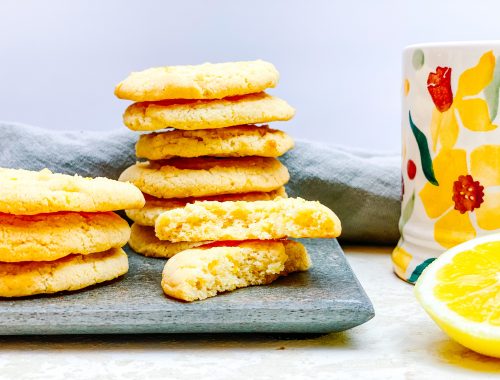
Lemon Sunshine Cookies with White Chocolate
18th March 2021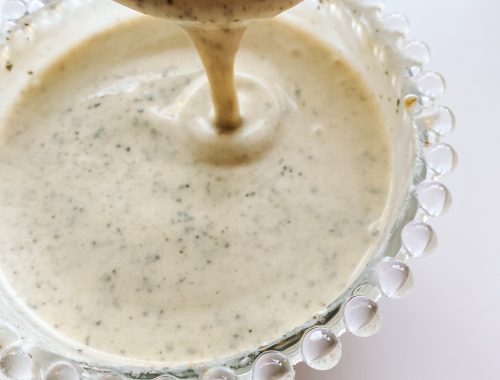
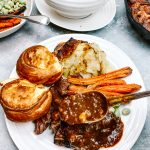
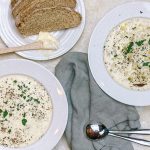
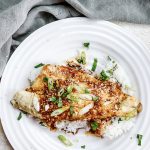
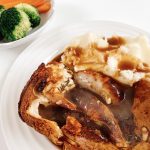
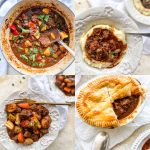



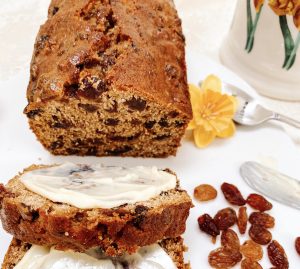
One Comment
Emma
I had a veggie version and it was absolutely incredible- not really like something I had ever tried before. Delicious!